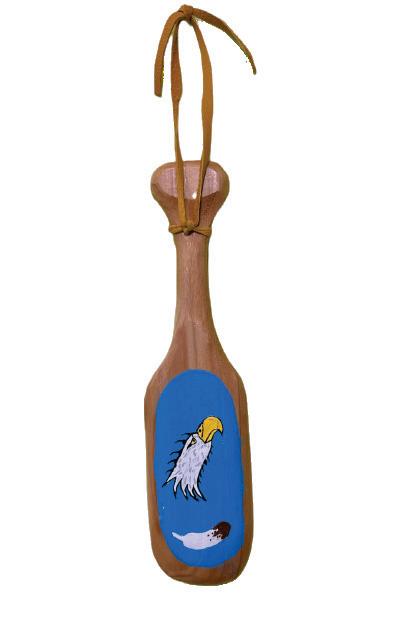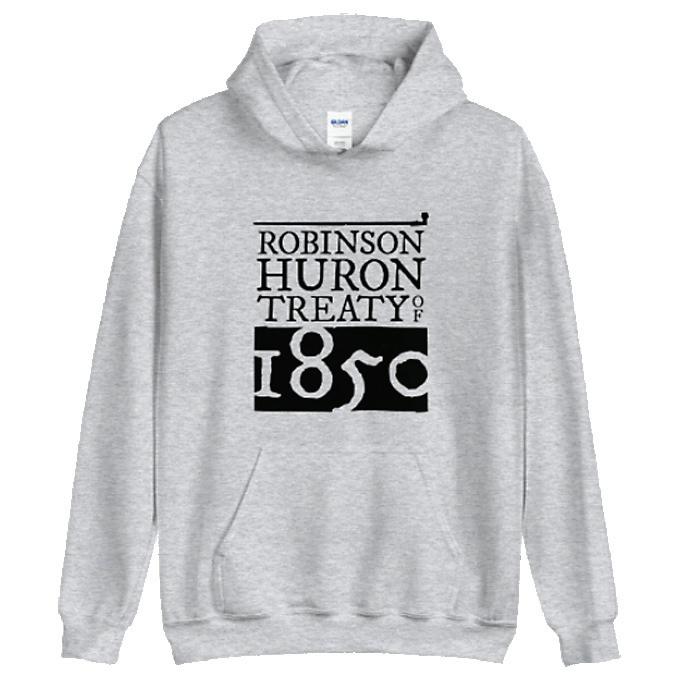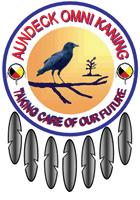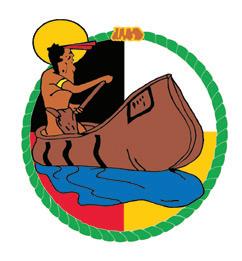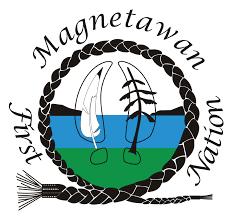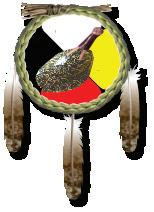





 Aanii, boozhoo, kina wiiya,
Aanii, boozhoo, kina wiiya,
On behalf of the Political Working Group (PWG) of Ogimaak for Robinson Huron Waawiindamaagewin, we are pleased to present the Daagwaagi 2022 issue of our E-Wiindamaagejig: The Robinson Huron Treaty Times. Our Robinson Huron Waawiindamaagewin (RHW) team has been working very hard to bring you this latest issue.
Our cover features the faces of many of our youth who attended our 2022 Robinson Huron Treaty of 1850 Treaty Gathering: Restoring the Balance, hosted by Nipissing First Nation and Dokis First Nation. Our Treaty Gathering is the feature of this issue—it was a truly meaningful experience for all who attended, with more than 400 in-person guests and over 100 online viewers. We at RHW look forward to beginning plans for future gatherings.
In this issue, we also wanted to highlight some of the Treaty Governance efforts RHW has been advancing from our Strategic Workplan. Some of the projects highlighted in this issue include our Use and Occupancy Mapping Study, Treaty Curriculum Framework development, Treaty Relationships, defining Traditional Anishinaabe Governance and Treaty Signage, as well as our Desktop Study on Community Infrastructure needs.
We share all of this with the goal of creating discussion documents to begin negotiations with the Crown in reconciling our Treaty Relationship. We hope that our magazine can help to keep you informed of these developments, as well as introduce you to some of our Treaty Anishinaabe team working in our communities.
We are always looking for innovative ways to share information and provide feedback with our communities. If you have any ideas for stories or features, or have any members in your community who may be interested in sharing their story, please have them reach out to our team. We hope you enjoy this Daagwaagi 2022 issue of our magazine.
Miigwech.
In Unity and Strength, Earl Commanda Executive Director, Robinson Huron Waawiindamaagewin
Executive Director, Robinson Huron Waawiindamaagewin

facebook.com/Waawiindamaagewin
youtube.com/channel/UClC0qXOPb_HsilsZZ8TgHXQ




Our Daagwaagi 2022 cover features students from Nbisiing Secondary School in Nipissing First Nation.
Back row (left to right): Zander McKenzie, Aiden Corbeil, Jason Potts-Paul, Dominic Iqulik, Evan Lazarus, Hayden Paul Martin, Lea-Marie Sutherland
Middle row (left to right): Kyle Perrin, Hannah Rumph, Abigail Hopkins, Sierra Commanda-Warner, Makayla Wynne
Front row sitting (left to right): Jeremy McDaniel, Niibin Nakogee, Mya Katt
Front row (lying on side): Jaqueline McDaniel


We had youth from all over Robinson Huron Treaty Territory attend our 2022 Robinson Huron Treaty of 1850 Treaty Gathering. They shared their energy, smiles and laughter. Our Elders and Youth Forum was held on Wednesday September 7, 2022, and we had many schools and classrooms join us in person and virtually. We are grateful for our youth contributions and feedback, including a recommendation that we plan a Youth Summit. Our team listened and we are committed to organizing this, and we hope to host the first Youth Summit in 2023.
Read the full Robinson Huron Treaty of 1850 Treaty Gathering story on page 36.

If you have any questions or comments about the Daagwaagi 2022 issue of E-Wiindamaagejig: The Robinson Huron Treaty TImes, or would like to share any feature story ideas for our next issue, please send an email to: Cheryl Recollet, Director of Research and Communications, Cheryl@waawiindamaagewin.com.
Robinson Huron Waawiindamaagewin
Robinson Huron Treaty Litigation Fund
Cheryl Recollet, Jolene Recollet, Peter Recollet, Melanie Laquerre, Vendela Edmonds
Melanie Laquerre
Earl Commanda, Barret Dokis, Sam Manitowabi, Steven McCoy, Daniel McCoy, Vendela Edmonds, Josh Manitowabi, Alan Corbiere, Susan Chiblow, Mackenzie Sayers, Dmitri Ashawasegai
Melanie Laquerre, Stefanie Recollet, Benedict Moran, Mike Kaiser
Daagwaagi 2022
Robinson Huron Waawiindamaagewin
473-A, Hwy 17 West Cutler, Ontario P0P 1B0
Phone: 1-877-633-7558
www.waawiindamaagewin.com
All content produced in E-Wiindamaagejig: The Robinson Huron Treaty Times is the property of the Robinson Huron Waawiindamaagewin and the Robinson Huron Treaty Litigation Fund. Reproduction of content is strictly prohibited without explicit permission. If you would like to request to use this content, please contact Cheryl Recollet at Cheryl@waawiindamaagewin.com.

We at the Robinson Huron Treaty Litigation Fund (RHTLF) and Robinson Huron Waawiindemaagwin (RHW) were really excited about creating this new edition of E-Wiindamaagejig: The Robinson Huron Treaty Times. It is filled with interesting and informative articles and photos about all kinds of happenings in and around the Treaty area.
In this issue, we feature an important recent event—our annual Robinson Huron Treaty of 1850 Treaty Gathering that was held in Nbisiing First Nation. The three-day event took place from September 7 to September 9, 2022. The weather was beautiful and the location was magnificent. Unfortunately, I was not able to participate in person due to my coming down with COVID-19, however I was able to participate virtually.
I was very sad to have missed the opportunity to attend the gathering in the Teaching Lodge with the Elders and youth of the Treaty area. I did though, make some opening remarks to the assembly on the morning of September 8, 2022. By way of Zoom, I spoke of the progress of our Treaty Annuities Litigation and what it meant for me. I related the findings of Justice Patricia Hennessy of the Ontario Superior Court, wherein she relied on four major principles of the Treaty relationship: Respect, Reciprocity, Responsibility and Renewal. These principles were outlined by Elders, scholars, and Chiefs who testified in court to successfully convey the Anishinabek perspective regarding the Treaty relationship with the Crown. These principles are understood to be used in keeping the Treaty alive and relevant so that the Anishinabek and the settlers could live in peace and harmony in the shared territory as outlined in the Treaty. If one Treaty party or the other should ignore their responsibilities towards the Treaty, problems will arise. The Crown governments have, for 172 years, ignored the Treaty relationship and failed to live up to the agreement made in 1850, that the annuity would be augmented as Crown revenues continued to surge. Therein lies the injury that forced us the take our grievance to the court.
So, let us all as we move forward with honesty and integrity, and guide our relationship by honouring the Treaty principles.
Miigwech,
Mike Restoule Chair, Robinson Huron Treaty Litigation Fund
facebook.com/RobinsonHuronTreatyAnnuity1850
twitter.com/1850RHTreaty
The Annuities Litigation was commenced in 2012 through a Notice of Claim to the federal and provincial Crowns. The claim is seeking damages and declarations related to the augmentation clause in the Robinson Huron Treaty which was entered into between the Lake Huron Anishinabek and the Imperial Crown on September 9, 1850.
The litigation is being case managed by Justice Patricia Hennessy in the Ontario Superior Court of Justice in Sudbury. Early on a decision was made to hear the claim in three (3) stages. The first stage dealt with the interpretation of the augmentation clause, the second stage dealt with Ontario’s technical defences and the third stage will deal with all other issues, including how much compensation is owed to the Lake Huron Anishinabek.
In Stage One Justice Hennessy ruled in favour of the Robinson Huron Anishinabek, finding the Crown has a mandatory and reviewable obligation to increase the collective annuities of the Lake Huron Anishinabek. This interpretation was largely upheld by the Ontario Court of Appeal in their November 5, 2021, decision.
In Stage Two Justice Hennessy again ruled in favour of the Robinson Huron Anishinabek rejecting the limitations and Crown immunity defences advanced by Ontario. This decision was completely upheld by the Ontario Court of Appeal in their November 5, 2021, decision.

The legal team, lead by Dave Nahwegahbow and Dianne Corbiere are now preparing for the Stage Three trial which
will commence on January 16, 2023, in Sudbury. The Stage Three trial will deal with issues such as how much net Crown resource revenues have been collected from the territory since 1850, what is an appropriate share of those net Crown resource revenues owed to the collective Robinson Huron Anishinabek, and which Crown (Canada, Ontario, or both) is liable to make payment.
At the same time, the legal team is also making preparations for an appeal to the Supreme Court of Canada. In January 2022, Ontario brought an application seeking permission from the Supreme Court to appeal the Ontario Court of Appeal’s November 5, 2021, decision on Stage One and Two. This appeal to the Supreme Court has not been set down for a date, but will likely be heard sometime in the spring of 2023.
The Litigation Management Committee, comprised of six (6) trustees from Robinson Huron Treaty First Nations, and the legal team are still hopeful and pushing for a negotiated solution between the Crowns and Robinson Huron Anishinabek. However, this requires a more concerted effort from our Treaty partners, Ontario and Canada.
January 2023
The Stage Three Trial dates are currently set to begin in January 2023. The Stage Three Trial will consider all remaining issues, including the amount of compensation, if any, is owed to the First Nations plaintiffs.
January 4, 2022
Ontario brings an Application for Leave to Appeal to the Supreme Court of Canada. The Supreme Court has not yet decided if it will hear Ontario’s Appeal.
June 1-3, 2021
The Ontario Court of Appeal heard Ontario’s appeal of the Stage Two decision. Canada has not appealed.
June 26, 2020
Stage Two Trial Decision: Justice Hennessy, again, ruled in favour of the RHT and RST First Nations, finding the plaintiffs’ claims are not barred by Ontario’s limitations legislation and that Ontario does not benefit from the doctrine of Crown immunity.
September 25, 2017
Stage 1 begins with opening statement of RHT plaintiffs.
2010
Formation of the RHT Litigation Fund.
July 1764
Council of Niagara, 1700 Indigenous inhabitants gathered, a diplomatic exercise where the British sought to renew and strengthen the Covenant Chain.
February 10, 1763
Signing of Treaty of Paris.
Stage One and Two Appeal to be heard at the Supreme Court of Canada
June 23, 2022
The Supreme Court of Canada releases its decision to proceed with hearing Ontario’s appeal of the Robinson Treaties annuity case.
November 5, 2021
Ontario Court of Appeal releases its decision on the Stage One and Two appeals. The Ontario Court of Appeal upheld Justice Hennessy’s interpretation of the augmentation clause and rejected Ontario’s technical defences.
April 13-28, 2021
The Ontario Court of Appeal heard Ontario’s appeal of the Stage One decision. Canada did not appeal.
December 21, 2018
Stage One Trial Decision: The Court rules that the Crown has a mandatory and reviewable constitutional obligation to increase the annuity to reflect the economic value the Crown receives from the Treaty Territory.
2012
Notice of claim filed.
September 9, 1850
Signing of the Robinson Huron Treaty.
October 7, 1763
Royal Proclamation set out the principles for Treaty making, Declaration of the Crown, affirmed Aboriginal title and ownership of lands.
Below is an excerpt of the Affidavit of Jim Morrison describing the Mica Bay Incident, which was entered as an exhibit during Stage 1 of the litigation. Mr. Morrison’s account of the Mica Bay Incident agrees with the findings of Justice Hennessy in her Stage 1 decision.
While Commissioners Vidal and Anderson were making their way back along Georgian Bay, some of the Anishnabek were taking direct action against the mining companies. On November 16, 1849, T.G. Anderson boarded the steamer Gore at Penetanguishene, where it had just arrived from Sault Ste. Marie.
Anderson was told that on November 9, an expedition of as many as one hundred Ojibwa and Métis, led by Chiefs Shinguaconse, Nebenaigoching and Naoquagabo, and accompanied by Allan Macdonell, his brother Angus, and an associate named Wharton Metcalfe, had left by boat for the Quebec Mining Company location at Mamainse (Mica Bay), where they reportedly intended to halt the operations and force out the miners and their families.

Anderson immediately wrote to the Hon. Robert Baldwin on the subject, and the following morning Captain Fraser of the Gore started on horseback for Toronto (the new
provincial capital) carrying Anderson’s letter, as well as reports on the incident from Anglican missionary F.A. O’Meara, the steamer’s owner Charles Thompson, and others.
The Reverend O’Meara’s letter to Superintendent General Campbell, dated at Sault Ste. Marie on November 12 expressed a hope that it was not too late in the season for the government to “put a stop to such outrages on property for the future.”
The missionary claimed that the Ojibwa had been “duped by interested white people,” but trusted that Lord Elgin would not “visit them with the just consequences of the foolish part they acted at the late visit of the Commissioners to them. They are in all respects children and required to be dealt with as such.”
THE REVEREND O’MEARA’S LETTER TO SUPERINTENDENT GENERAL CAMPBELL, DATED AT SAULT STE. MARIE ON NOVEMBER 12 EXPRESSED A HOPE THAT IT WAS NOT TOO LATE IN THE SEASON FOR THE GOVERNMENT TO “PUT A STOP TO SUCH OUTRAGES ON PROPERTY FOR THE FUTURE.”




The steamer owner Thompson reported hearing that the expedition had purchased “a quantity of muskets and scalping knives.” He had also heard that “thirty five Indians from the American side with their chief” were taking part, and that “the wild Indians of the head of Lake Superior” had also been invited, some of whom were reportedly already on their way to Mica Bay. He therefore offered to hold the steamer Gore in readiness in case it was needed for any purpose.
T.G. Anderson warned in his own letter that if immediate steps were not taken to “arrest such proceedings and to intimidate the Indians and half breeds, they will be likely to suppose that Mr. McDonald has overawed the Government and the consequences may be most lamentable.”
The Executive Council held an urgent meeting in Toronto on the morning of November 19 to discuss the reports of trouble on Lake Superior. Because the Governor General was absent in Drummondville (in Canada East), some of the Council members, accompanied by Civil Secretary T.E. Campbell, visited the local military detachment, and asked the commanding officer, Major J.T. Esten, to send up troops to the mine site, on the grounds that “the lives
and properties of Her Majesty’s Subjects at the threatened points of attack were in danger.”
Council members stressed the need to take action before the ice set in for the winter. Major Esten agreed to put together an expedition, provided the Governor General telegraphed him the necessary instructions. From Drummondville, Lord Elgin approved the deployment that same afternoon. One hundred men of the Toronto Rifle Brigade, Captain Astley Cooper commanding, immediately set off for Nottawasaga Bay, where the Gore was waiting to carry them back up Lake Huron.
On the same day, the Council also issued special commissions as Justices of the Peace under the 1846 Statute (in Lord Elgin’s name) to several individuals resident on the upper lakes, including Hudson’s Bay Company (HBC) officers, mining company representatives (such as Archibald Campbell at Bruce Mines), Crown Land Agent Joseph Wilson, and Indian Superintendent George Ironside at Manitoulin.
On November 20, Provincial Secretary James Leslie ordered George Ironside to head at once for Mica Bay, in case his services were needed.

What provincial officials had done was highly irregular, and Lord Elgin had in effect covered for them. When dispatching the troops, the Governor General had failed to consult the Commander in Chief of the Forces, Lt. General William Rowan, and he was forced to defend his conduct.
As Commander in Chief Rowan complained on November 23, the “Officer Commanding at Toronto has furnished the Detachment of Troops in aid of the Civil Power without having received any written requisition or official application to that effect, as required by the Orders and regulations of the service.”
In a private letter to the Colonial Secretary on November 21, 1849, Lord Elgin blamed his predecessor Lord Metcalfe’s administration for causing the problems in the first place. “Metcalfe’s Government of Jobbers gave licences to certain mining Companies in that quarter without making arrangements with the Indians, and I have been occupied for the last two years in getting some compensation for them. We had finally settled with them as we supposed when some blackguard whites as it appears induced some of them to attack one of the mines. I have been obliged to send up a detachment of soldiers to protect the miners.”
At the Indian Department, Assistant Superintendent General George Vardon took a different view. He blamed the problem on his superior officer, Major Campbell, and on Lord Elgin himself. “So much for allowing Mr. McDonald to parade himself as the Agent for the Indians and the Governor General passing over the Department,” he wrote Superintendent D.C. Napier on November 21, telling him about the dispatch of the troops. “I think in time they will find out—that we know as much as they do; ordinary decency would have saved all this.”
He said much the same thing to Superintendent J.B. Clench, telling him that the whole problem stemmed from “Major Campbell allowing the Indians to pass over the Department and let them think Macdonell was anybody.”
In his official dispatch to Earl Grey on the subject on November 23, 1849, the Governor General enclosed copies of the letters (from the Reverend O’Meara and others) which had persuaded him to authorize the dispatch of troops, along with a copy of the November 19 Minute of Council, “embodying the views of the Government.”
However, he said that the information so far received was scanty and that he hoped the rumours “will eventually prove to have been much exaggerated.” He outlined for the Colonial Secretary the entire history of the dispute, pointing out that when he had first arrived in the Province in 1847, “complaints were addressed to me by certain Indian Tribes who alleged that the miners were trespassing on their property.”
He attached copies of the November 1847 report of Commissioner of Crown Lands D.B. Papineau (“not altogether satisfactory to me”), as well as the August 1848 report of T.G. Anderson (“favourable to the Indians”), and said that because the information Anderson had collected was “not in all particulars sufficiently complete to enable the Government to propose terms to the Indians,” the latter and Alexander Vidal had been sent up again in the summer to complete those inquiries. They were on their return from their mission when the alleged disturbances broke out.
Lord Elgin repeated what he had said more forcefully in his private letter to Earl Grey, namely that he “regretted that steps were not taken to investigate thoroughly and extinguish all Indian claims before licences of exploration or grants of land were conceded by the Government in this Territory. This omission is the pretext for the present disturbances and renders the Indians much more difficult to treat with.”
Nevertheless, he assured the Colonial Secretary that they were “a docile people and cognizant of the steps which the Government is now taking to ascertain and satisfy them.” There could be little doubt, he concluded, “that they are seduced into violent courses by the evil counsels of unprincipled white men.”
“METCALFE’S GOVERNMENT OF JOBBERS GAVE LICENCES TO CERTAIN MINING COMPANIES IN THAT QUARTER WITHOUT MAKING ARRANGEMENTS WITH THE INDIANS, AND I HAVE BEEN OCCUPIED FOR THE LAST TWO YEARS IN GETTING SOME COMPENSATION FOR THEM.”
The Commander in Chief, General William Rowan, was actually more familiar with the Anishnabek than Lord Elgin was. From 1832 to 1836, he had been military and civil secretary to his patron Sir John Colborne when the latter was Lieutenant Governor of Upper Canada. In that capacity, Rowan had met several times with Chief Shinguaconse, the Reverend William McMurray, and those promoting the Anglican mission settlement at Sault Ste. Marie. He also knew W.B. Robinson very well.
As a consequence of the Mica Bay incident, General Rowan decided to send up his own special emissary to join the troops, both as an interpreter and potential mediator (and as an independent source of information). This was Captain Charles Oakes Ermatinger Jr. of the Royal Montreal Calvary, who had been born on Lake Superior in 1802. His younger brother William Ermatinger was superintendent of the Montreal police. Their father, Charles Ermatinger Sr. (who died in 1833) was a former Nor’wester who later became an independent trader on the British side of the St. Marys River. (The family mansion is still a prominent local historic site).
Their mother, Charlotte Katawabide, was the daughter of a prominent Chief of the Lake Superior Ojibwa. As General Rowan explained to Lieutenant General Lord Fitzroy Somerset, his superior officer in London on November 24, Charles Ermatinger’s mother “belonged to the Tribe of Indians who have long possessed that Tract of country—he was born there, speaks the language— and is moreover, I am informed, one of their Chiefs. He is a man of mild, conciliating manners, and possessing influence over the Indians (who are represented to be a peaceable, inoffensive race)—which may prevent any serious collision with the Troops.”
At the General’s request, Lord Elgin also gave Captain Ermatinger a commission as a Magistrate under the 1846 provincial legislation. Over the course of the winter and following spring, Captain Ermatinger would provide regular reports to General Rowan, which sometimes contradicted the information obtained by the civil authorities.
Superintendent T.G. Anderson finally arrived back in Toronto on November 29. He immediately met with Civil Secretary T.E. Campbell, Assistant Superintendent General George Vardon, the Governor’s brother Robert Bruce, and Lord Elgin himself. The Governor General called Anderson in the following day for further talks, and it can be assumed they fully discussed the results of the inquiry that he and Alexander Vidal had just carried out.
George Vardon wrote Superintendent D.C. Napier in Montreal on the 30th to tell him that Anderson also intended to point out to Lord Elgin “that all the evils that have occurred are entirely from the manner in which the Department has been passed over and I am inclined to think his representations will do good.” Vardon added that he himself intended to go see the Provincial Secretary and other Members of the Executive Council “and bring the same subject under their notice. The Department shall not be let down if I can help it.” The most important news that George Vardon conveyed to Colonel Napier, however, was that Major Campbell had just resigned his position and returned immediately to Montreal. Vardon was happy to see him gone, telling Napier that “in the course of a long official life he is the first person I ever met who seemed to have made it his study to insult those below him in office as he did.”
To replace Major Campbell, Lord Elgin immediately appointed his younger brother, Lt. Colonel Robert Bruce, as Civil Secretary and Acting Superintendent General (but without any extra salary). Since Lord Elgin’s arrival in 1847, Colonel Bruce had been serving as his brother’s Military Secretary. In that capacity, he was already handling the correspondence with the military authorities over the dispatch of troops to Lake Superior. As it turned out, the soldiers of the Rifle Brigade never made it to Mica Bay. Due to very rough weather on Georgian Bay, they were delayed leaving Penetanguishene on the steamer Gore
On their way to Sault Ste. Marie, the steamer stopped first at Manitowaning to pick up Indian Superintendent
AS A CONSEQUENCE OF THE MICA BAY INCIDENT, GENERAL ROWAN DECIDED TO SEND UP HIS OWN SPECIAL EMISSARY TO JOIN THE TROOPS, BOTH AS AN INTERPRETER AND POTENTIAL MEDIATOR (AND AS AN INDEPENDENT SOURCE OF INFORMATION).
George Ironside and the French River Chief Mishequonggai (later a Robinson Treaty signatory) and two of his warriors, who had been hired from the local Anglican mission settlement to assist Ironside as guides and runners (and intermediaries with the supposedly hostile Anishnabek). After another stop at Bruce Mines for the Montreal Mining Company manager (and Justice of the Peace) Archibald Campbell, the Gore finally arrived at Sault Ste. Marie on December 2nd. Captain Cooper immediately engaged the American propeller Independence to take his men, George Ironside, and Chief Mishequongai and his warriors to Mica Bay.
However, the vessel was caught in a severe gale on Lake Superior and ran aground on December 8 at Whitefish Point, in the process losing a bateau purchased from the HBC. On a second attempt, they were turned back by strong winds and ice above Sault Ste. Marie. The detachment therefore returned to Sault Ste. Marie took up residence at the HBC post for the winter.

In the meantime, all of the alleged ringleaders of the expedition to halt the mining operations, except Wharton Metcalfe, who remained at the mine, voluntarily presented themselves to Magistrates George Ironside
and A.H. Campbell. The Magistrates had them arrested on December 3 on informations laid by John Bonner, the Resident Superintendent for the Quebec.
Denied bail in Sault Ste. Marie, Chiefs Shingwakonce and Nebenaigoching, the Macdonell brothers, and Pierre Lesage and Charlot Boyer were all taken down to Toronto on the return trip of the steamer Gore (its last of the season).
The two Chiefs would sign the Robinson Huron Treaty a year later, and the two Métis leaders would also become Treaty beneficiaries. (Descendants of Pierre Lesage are members of Garden River First Nation, and descendents of Charlot Boyerare members of Sagamok First Nation.) When George Ironside returned to Sault Ste. Marie on December 13 from the attempted trip to Mica Bay, he found that Wharton Metcalfe had arrived the day before from the mine site. Ironside had him arrested and taken into custody by Joseph Wilson. Since the Gore had already left with the other prisoners, Wilson, acting as a special constable, was deputed to escort Metcalfe to Toronto as soon as the ice was safe, Metcalfe having agreed to walk as far as Penetanguishene.
“Relationships cannot be built or reconciled in a courtroom,” Chief Scott McLeod noted at the beginning of our call. It is a statement that has echoed across Robinson Huron Treaty leadership and it resonates deeply with Chief McLeod.
Entering his third consecutive term and his seventh year of leadership, Chief McLeod has been a steady guide for Nipissing First Nation. The people of Nipissing First Nation, known as the Nbisiing Anishinaabeg, are of Ojibwa and Algonquin descent and have lived in the area of Lake Nipissing since time immemorial. When the Robinson Huron Treaty was signed in 1850 it was signed by one of Chief McLeod’s relations—Chief Shabogesic.
“On September 9, 1850, when our leaders gathered in Baawating (Sault Ste. Marie), the Robinson Huron Treaty was signed with a pen,” said Chief McLeod. “It shows how much power there is in a pen and in making such an agreement between nations.”
When the Robinson Huron Treaty Litigation Fund (RHTLF) team was thinking of new ways to reach out to Ontario officials and encourage them to see the significance of honouring the Treaty, Chief McLeod’s suggestion was a simple one—send them a pen.
“The symbolism of our relationship has come full circle. We used a pen to bind our relationship back in 1850 so it only makes sense that we would bind our relationship again through the strength of the pen,” explained Chief McLeod.
The pens read Respect, Reciprocity, Responsibility and Renewal to honour the Anishinabek perspective and to highlight the decisions Justice Patricia Hennessy made in Stage 1 and Stage 2 of the annuities trial. On April 5, 2022, within the territory of the Chippewas of Rama, the pens were part of the Litigation Management Committee’s (LMC) Pipe Ceremony led by Elder Leroy Bennett.
The Ceremony was to prepare the LMC for Negotiations with Canada and Ontario representatives who observed the ceremony.
For Chief McLeod, the story of the pens and the Robinson Huron Treaty are both about a relationship.
“I have done a lot of reading about Treaties and how a Treaty is a living breathing document that outlines the relationship between nations. Just like a plant or flower, that relationship needed to be tended to. A Treaty is not meant as a static point in time, it is not to be signed and forgotten about—if you did that with a plant it would die,” said Chief McLeod.
He continued, “There is a lot of spirit in the Treaty document and moving forward we need to find ways to come together and look at our Treaty relationship to make sure we are on the right path. I recognize that needs can change on both sides of a relationship, so there needs to be a forum to discuss this. In the past, after the Treaty was signed there was no follow-up or maintenance of that relationship. It was left to degrade and that is why we are in court today.”
Chief McLeod is optimistic that the Anishinabek perspective and principles of Respect, Reciprocity, Responsibility and Renewal will lead the way as the Treaty relationship is redefined through both the Annuities Case and honourable relationships.
“THE SYMBOLISM OF OUR RELATIONSHIP HAS COME FULL CIRCLE. WE USED A PEN TO BIND OUR RELATIONSHIP BACK IN 1850 SO IT ONLY MAKES SENSE THAT WE WOULD BIND OUR RELATIONSHIP AGAIN THROUGH THE STRENGTH OF THE PEN,” EXPLAINED CHIEF MCLEOD.

Traditional ceremonial practices, cultures and customs differ across the Indigenous country of Turtle Island. From the Dene people to the Northwest down to the Dakota people in the south and to the Anishinaabe people of the region surrounding the Great Lakes, sometimes the customs, cultures and protocols can be drastically different across the various territories.
Many of these traditional customs and protocols are only taught to certain people who have gone through the proper procedures and they have learned how to interpret these traditions and harness the energy that comes with being a spiritual knowledge holder.
Having the right people aboard to provide the Robinson Huron Treaty Litigation Fund (RHTLF) team with the proper guidance about traditional customs and protocols was extremely important to the team because never has the colonial court system recognized Anishinaabe culture and customs as part of a court proceeding in the history of Canadian law—until 2017 when the RHTLF team came before Justice Hennessy during Stage 1 of the Annuities Litigation.
“We were the first ones to have the courts officially recognize and include our culture as part of the court proceedings,” said Peter Recollet, Vice-Chair of the RHTLF.
With traditional customs in mind, the RHTLF team knew how important it was to incorporate proper traditional protocols alongside the court proceedings to help guide their decision-making process. The team knew it was imperative they brought in the appropriate person who understood the local customs and teachings of the Anishinaabe people from the 21 First Nation communities along the north shore territory of Lake Huron that are signatory communities of the Robinson Huron Treaty of 1850.
The first step to bring in traditional culture and customs alongside the court proceedings was to choose the proper person as the team’s Spiritual Advisor. The RHTLF team decided to present tobacco to and ask the knowledgeable and experienced Leroy Bennet, who is a member of Sagamok First Nation, to be the team’s Spiritual Advisor.
“How do we bring in that ceremonial piece to the process? These were big questions beyond most people on our team so that’s why we brought in Leroy Bennet,” said Recollet while speaking about the importance of incorporating the appropriate ceremonial customs alongside the court proceedings to help guide the long legal journey ahead.
“WE WERE THE FIRST ONES TO HAVE THE COURTS OFFICIALLY RECOGNIZE AND INCLUDE OUR CULTURE AS PART OF THE COURT PROCEEDINGS,” SAID PETER RECOLLET, VICE-CHAIR OF THE ROBINSON HURON TREATY LITIGATION FUND.
Bennet’s Anishinaabe name is Hummingbird and he is part of the Bear Clan. He is a Cultural Consultant and Ceremony Facilitator who has done work at the local, national and international levels. Bennet accepted tobacco from the RHTLF team to do the work and in 2017, the initial ceremonies begun by conducting a sweat that day before the initial court proceeding started in the Thunder Bay Courthouse.
“Ceremonies are actually a part of the Anishinaabe identity and passing along tobacco in exchange for spiritual guidance is a very significant practice in our culture,” said Bennet describing why it is important to include ceremony alongside this historic court case.
To help clear their minds and cleanse their thoughts, a sweat lodge ceremony was conducted by the team. Many important dignitaries who are a part of the court proceedings were present and participated in the sweat, which included most of the lawyers from both sides, Chiefs from surrounding First Nations and Justice Hennessey.
The next day started with a Pipe Ceremony that included all the dignitaries, Chiefs, lawyers and Justice Hennessey. This was a first in a Canadian court proceeding. Having all the different people present for the Pipe Ceremony, Bennet understood the importance of choosing the proper words that would bring clarity to the Anishinaabe
identity while recognizing the importance of the colonial court case ahead of them.
“There are two journeys that we are currently on. One is a spiritual journey, but the other is a legal journey and figuring out how to keep those side by side, that’s the hard part,” said Bennet describing how he handled walking in two worlds that are inherently different in every aspect yet now existing in the same space and time.
The following day, with the initial court proceedings taking place inside the Thunder Bay Courthouse, outside, the RHTLF team, along with their Spiritual Advisor, Leroy Bennet, decided that a sacred fire should be started.

With the blessing of local Anishinaabe community Chiefs and dignitaries, Bennet started a sacred fire that continued to burn and became a beacon to all those who came to the grounds outside the courthouse in Thunder Bay to show their support over the next five weeks.
Those first few days in September 2017 outside the Thunder Bay Courthouse saw hundreds of people come and go from dignitaries like Assembly of First Nations National Chief, Perry Belgrade, to leaderships from local First Nation communities such as Fort Williams, Whitesand and Red Rock to the curious passerby who wanted to know what was happening.

“We probably had almost a thousand people stop by the grounds during those first four to five days,” said Bennet recalling those autumn days outside the Thunder Bay Courthouse where a teepee was erected and a sacred fire was burning and did not go out for 5 weeks.
The search for the proper person to help bring balance and guidance brought them to Martina Osawamic who had some previous contact with the Vice-Chair, Peter Recollet. Osawamic is a member of Wiikwemkoong Unceded Territory. She currently resides in Sudbury Ontario and works part-time as Grandmother in Residence at Cambrian College and Friendship Centre for students and clients. Osawamic’s Anishinaabe name is Oginii-Kwe, she is part of the Beaver (Amik) Clan and she has the Wolf (Miingan) and Bear (Makwa) as spirit helpers.
In September 2021, Osawamic was on her way to take part in the Robinson Huron Treaty (RHT) of 1850 Treaty Gathering in Sault Ste. Marie when she received a phone call from Recollet. Peter asked her if she could conduct a water ceremony in the morning because the other person they had scheduled to conduct the ceremony was no longer able to make it because of an emergency.
On the very first day in 2017, Bennet took stock of the team that was assembled around him and noticed a certain element was lacking in the dynamics and structure of the group assembled that he needed to address. He knew the topic may be sensitive for some people.
“Until the voice of our (Anishinaabe) women are heard, we will never understand balance,” said Bennet to the group of people who were present for the initial pipe ceremony that day in Thunder Bay.
Indeed, the role of the Anishinaabe women in the culture and community was once held in high regard amongst Anishinaabe leadership and community yet the structural elements of a patriarchal system continue to diminish and silence their voices. Bennet quickly brought that to the attention of the RHTLF team.
“When we started out the court case that’s the one thing that I noticed was a lack of women there,” said Bennet as he recalled those early days of the court proceedings. “How can we talk about being a nation when we exclude our women?”
From that moment on, Bennet and the RHTLF team began searching out the proper person to bring aboard as their Grandmother Advisor who would bring more balance to the group dynamics along with the traditional knowledge and life experience necessary to carry out the duties required for the role.
Osawamic, who always carries her bundle with her, was prepared and agreed to carry out the water ceremony in the morning for the start of the annual RHT of 1850 Treaty Gathering. Martina, with the assistance of her daughter, Lisa Osawamic, sang the songs and carried out the ceremony to kick-off the 2021 RHT of 1850 Treaty Gathering for the team and participants.
“In anything that we do, we need that balance,” said Osawamic speaking about having both male and female voices represented on the RHTLF team. “We (women) have very strong voices and that’s what is needed within the organization to provide that balance.”
Since the 2021 RHT Gathering, Osawamic has been asked to participate with the RHTLF team as their Grandmother Advisor to ensure more balance is represented in the team’s cultural customs and protocols.
“She has gone through all those experiences of life,” said Bennet on why they choose to bring Osawamic in as their Grandmother Advisor. “She can draw upon those experiences to help guide people.”
As the RHT Litigation Team moves forward with the court proceedings along one path and traditional practices on another path, one of the biggest challenges will be ensuring that both journeys are guided by the true intentions that our ancestors had in mind when the Robinson Huron Treaty was signed in 1850.
“IN ANYTHING THAT WE DO, WE NEED THAT BALANCE. WE (WOMEN) HAVE VERY STRONG VOICES AND THAT’S WHAT IS NEEDED WITHIN THE ORGANIZATION TO PROVIDE THAT BALANCE,” SAID OSAWAMIC.
“CEREMONIES ARE ACTUALLY A PART OF THE ANISHINAABE IDENTITY AND PASSING ALONG TOBACCO IN EXCHANGE FOR SPIRITUAL GUIDANCE IS A VERY SIGNIFICANT PRACTICE IN OUR CULTURE,” SAID BENNET WHEN DESCRIBING WHY IT IS IMPORTANT TO INCLUDE CEREMONY ALONGSIDE THIS HISTORIC COURT CASE.

Aanii! In this edition of our E-Wiindamaagejig: The Robinson Huron Treaty Times, we are going to explore and discuss some of the elements that the team at Robinson Huron Waawiindamaagewin has been exploring as we examine processes and methodologies to reinstitute some of our traditional governance for our treaty area.
By Barret DokisThrough the Robinson Huron Waawiindamaagewin (RHW) Declaration, our leadership has acknowledged that the creator provided us with the ‘Great Law’ and the inherent right to govern ourselves and exercise our sovereignty. When we look at governance as a whole, we accept that there are varying levels of governance and levels of sovereignty. Most of us are familiar with community governance, in particular, the Indian Act Chief and Council model that governs most of our First Nation communities.
The intent of this article is to provoke thought and initiate debate on some of the components that make our governance systems, specifically as it relates to our Treaty relationships and shared territories, as opposed to community governance. One of RHW’s purposes is to facilitate a process through our Treaty relationship and develop methodologies for decision-making through our shared Treaty relationship. The organization, RHW, existence

will be to facilitate that decision-making process and distinguish when we need to come together as a collective to discuss Treaty matters.
For example, the collective of the Robinson Huron Treaty (RHT) of 1850 communities would not need to come together to discuss community by-laws, that is a sovereign decision that would be made by each individual community. On the other hand, the collective of our RHW communities may come together to discuss or even negotiate as a collective when it comes to resource extraction within the RHT lands. This could include an outright ban on certain resource extraction or activities such as aerial spraying.
This article will discuss our different levels of sovereignty, our relationships, incorporate ceremony, perspectives on our socio-economic and community well-being, and governance infrastructure.
THE COLLECTIVE OF OUR RHW COMMUNITIES MAY COME TOGETHER TO DISCUSS OR EVEN NEGOTIATE AS A COLLECTIVE WHEN IT COMES TO RESOURCE EXTRACTION WITHIN THE RHT LANDS. THIS COULD INCLUDE NEGOTIATING A FRAMEWORK FOR RESOURCE REVENUE SHARING FOR THE RHT AREA OR AN OUTRIGHT BAN ON CERTAIN RESOURCE EXTRACTION OR ACTIVITIES SUCH AS AERIAL SPRAYING.

A good place to start our thought processes for Treaty governance is looking at what sovereignty is, where it begins, where it ends, and who actually is the ‘sovereign’. The general or typical definitions of the sovereign would state that sovereignty references a self-governing state or the authority of a state to govern itself or another state. When we consider our ancestors thought processes though, the concept of a ‘state’ or ‘national sovereignty’ was likely not what they had in mind when considering themselves as self-governing people.
Some of the staff at RHW have proposed that there are many levels of sovereignty starting with the individual. On a daily basis we have the right to self-govern our lives through dozens, if not hundreds, of decisions we make throughout the day. These decisions will impact our general individual well-being. Some of these decisions may include things like what we decide to eat, when we go to bed and whom we choose to interact with. These micro-decisions collectively combine to influence our personal well-being or physical and mental health. We have to recognize that some decisions we make, don’t just impact our own wellbeing, but they impact our families and community.
The next level of sovereignty would likely exist within our family units or circles. For example, we typically have rules or accepted practices for our households, and we even have authority within that family sovereignty which is typically held by parents or family Elders. Through lived experiences and even a rank within the family, these individuals hold some of the decision-making authority for that family unit. And though there is a recognized authority within the family unit, decisions can still be made by the collective of the family depending on the specific matter at hand. We have even heard of our ancestors or Elders referencing family headwomen or headmen. These family

ON A DAILY BASIS WE HAVE THE RIGHT TO SELF-GOVERN OUR LIVES THROUGH DOZENS, IF NOT HUNDREDS, OF DECISIONS WE MAKE THROUGHOUT THE DAY. THESE DECISIONS WILL IMPACT OUR GENERAL INDIVIDUAL WELL-BEING.
heads were often sent to sit at community-level councils, which leads to our next level of sovereignty, community sovereignty
Community sovereignty is when we see sovereignty become much more complex in nature and often requires more advanced rules or even laws to establish a level of order within that community. Historically, for our people, that community would have been more likely considered a tribe comprised of many family units all sharing the same ancestry, language, culture, harvesting spaces, and governing practices. Collectively the community would have had to make some decisions like how much food will be allocated or rationed out for the upcoming season, the establishment of social rules of conduct or order, and perhaps decisions related to external factors such as relations with neighbouring communities, or even nations.
As noted, community sovereignty is where we see the need for more advanced or refined methods for decision-making and sometimes even record-keeping of decisions. Today, we often struggle with community sovereignty because our communities are typically governed by the Indian Act regime and the perceived

authorities of our Chief and Council come by way of this act. In this model, the authority of the Chief and Council is perceived as being delegated out by the Indian Act as opposed to emerging from a more traditional framework of community governance. We are, however, seeing many of our communities taking back that authority through selfgoverning processes, but there have been some criticisms that those self-governing agreements still invoke the authority of the Crown.
Our sovereignty beyond community is further complexed by a number of organizations or institutions such as the Assembly of First Nations (AFN) and here in Ontario, the Chiefs of Ontario. These organizations, which were created out of a need and necessity for us to coordinate and plan on a broader level at one time, seemed to have become outdated institutions with a confused sense of sovereignty. Especially when they continue to hold on to political bodies which gives a false perception of decisionmaking authority and representation at these levels. This past spring and summer, we saw less than 50 per cent participation in these decision-making tables, and sometimes less, which brings into question the relevancy of these so-called decision-making spaces.
Many communities are challenged by time, distance and capacity to participate in these spaces but are subject to the impacts of decision-making that takes place there. Some communities, or even entire regions, have decided to pull away from these spaces in order to assert a stronger position of sovereignty, either from a community level or in some cases a Treaty level, such as Grand Council Treaty #3 (GCT#3). This Treaty area, which refers to itself as the “Anishinaabe in Grand Council Treaty #3,” asserted at a Chiefs of Ontario meeting in 2021 that they would be pulling away from the decision-making space for Chiefs of Ontario so that they can focus on more direct relationships with other regions in Ontario, but also Crown entities which they have a Treaty agreement with. This direct relationship development process for GCT#3 included attending the last two RHT of 1850 anniversary gatherings and hosting some of the RHW staff and leadership at their meetings. Additionally, they have asserted that all Crown actions and decisions that impact their Treaty area, must be presented to their collective Treaty council and not routed through an external or condensed decision-making body.
At RHW, we are in the process of establishing a methodology for asserting Treaty-based sovereignty for the RHT communities. A clear example of how our Treaty area has already come together to assert Treaty sovereignty is the ongoing litigation process for the annuity component of our Treaty. Our community-based leadership came together as a collective of Treaty signatories and beneficiaries to address a common concern. A future example of a possible Treaty-based assertion of sovereignty would be banning aerial spraying within our Treaty area.
RHW expects this process of defining our Treaty sovereignty and the development of related governing processes to take time and will only happen through engagement and clarification of our relationships with each other and beyond.
The foundation of family sovereignty or community sovereignty is our relationships with each. Again, as we move along the spectrum of sovereignty, the complexity of our relationships begins to become more advanced much like the structures needed to support that sovereignty. At one time, our sovereignty or decision-making capacity was weakened by colonial and Crown governments with systemic and aggressive racism. The collective of the
Indigenous people of Canada needed to come together as a show of force during a time of extreme systemic and oppressive racism, and this is where organizations such as the National Indian Brotherhood, now referred to as AFN, were born. While the role and validity of these organizations have been put into question recently, even by the current National Chief who has been advocating for a comprehensive restructuring of the AFN, these institutions served a vital role in our history and path to our current sovereign processes.
We need to examine our relationships with organizations such as the AFN and the Chiefs of Ontario (COO) and even our own Provincial Territorial Organization, the Anishinabek Nation (formally the Union of Ontario Indians). Both the AFN and COO have had ongoing ‘restructuring’ processes that have lasted in some cases for at least 5 years now. Perhaps the struggle is that we don’t need to restructure these institutions but completely overhaul their purpose and remove the political element and collective decisionmaking that apparently takes place in these spaces. There is likely still room for these bodies and organizations, but likely in a more information sharing or analytical role, rather than an advocate or representative body.
RHW is in the early stages of examining the resources that will be required to establish a strong Treaty governance process for our Treaty area. Governing infrastructure such as communications, data sovereignty, human resources, culture and ceremony, policies, relationships, and technologies are some of the areas that will need to be developed. In this article, we are not going to spend a lot of time on these items and will explore these topics further in future articles and upcoming engagement discussions at the community level and broadly across our Treaty area.
It is important to note in this area that financial independence will be a key area of asserting a strong position of Treaty sovereignty. From the community level up to the Assembly of First Nations, our so-called sovereignty relies on contribution agreements or funding programs to govern ourselves at all levels. It is the objective of our leadership and the team at RHW to create a financially independent body to facilitate our Treaty sovereignty. This puts us in a space where we can establish and assert our own processes rather than depend on the limited financial resources provided by the federal Crown entity.
RHW EXPECTS THIS PROCESS OF DEFINING OUR TREATY SOVEREIGNTY AND THE DEVELOPMENT OF RELATED GOVERNING PROCESSES TO TAKE TIME AND WILL ONLY HAPPEN THROUGH ENGAGEMENT AND CLARIFICATION OF OUR RELATIONSHIPS WITH EACH OTHER AND BEYOND.

For this article, we are going to speak briefly about culture and ceremony so we can take a deeper look at this aspect of governance in a future edition of our magazine.
At RHW, the staff and leadership have begun the process of using our culture and ceremonies to guide and direct our decision-making. In 2021 at the annual RHT of 1850 Treaty Gathering in Bawating, RHW leadership and staff reached out for assistance to bring a teaching lodge to the site of the signing of the RHT of 1850. It was the first time this type of space was created for our leadership and people to gather to discuss our Treaty and our Treaty relations. At this year’s gathering in Nipissing First Nation, our Eastern doorway, the lodge was constructed once again to host some of our discussions.

RHW intends to continue to create and utilize this space for our leadership and people to gather as a Treaty region. Creating a process where we can gather in our lodge, a traditional governance space for our ancestors, is viewed as vital to creating a space for us to make critical and difficult decisions impacting our Treaty area. It is expected that we may require a form of contemporary documenting process or affirmation of the decisions made in our lodges,
but the key will be to create a healthy and effective space for our leaders and people to have healthy dialogue and govern our Treaty Lands.
In order for us to be able to participate in the ‘larger’ sovereignty spaces, such as community, our personal well-being is a factor. And our well-being is influenced by many factors such as our diet, our personal relationships, and the overall health of our family and community around us. Fred Kelly, an Elder and former leader from GCT#3, recently shared at the RHT of 1850 Treaty Gathering of 2022 that energy flows out from the individual. The decisions we make daily impact our overall health and well-being which in turn will influence our family’s well-being and ultimately our community. So when we approach governance, it is important that we have that healthy perspective and recognize the importance of shared values that create a healthy and thriving community.
Additionally, external factors will impact our communities and the communities around us. Our Treaty territory is extremely rich with a thriving ecosystem with many
lakes and forests, however settler governments and industry have depleted a lot of our resources, and in the process left us with broken communities. While we know that First Nation communities in Canada often have conditions similar to third-world conditions, a notable recent development in our Treaty area is the socio-economic conditions of the municipalities with our Treaty area.
In the East we have North Bay that has been a major transportation hub for the North for well over 100 years, the city of Sudbury was regarded as the ‘Nickel Capital of the World’ and the Algoma area was known for steel manufacturing and shared a notable forestry industry much like the rest of our Treaty area. However, many of our non-Indigenous Treaty partners living throughout our territory have been left with very little after all this resource extraction. There needs to be a new approach to how resources and our ecosystems are managed, ‘natural-law’ needs to be more prevalent, but also we need to ensure that the intended benefits of these resources, goes to the actual people living in our shared Treaty area.
Leadership and staff at RHW are going to continue to evolve and develop the noted discussions above, but also visit the RHT communities and visit with the people, Elders and youth in order to evolve these thoughts. At this year’s RHT of 1850 Treaty Gathering, RHW invited two Elder representatives from each RHT community to join us for a full day focused on Elder conversations with our youth in attendance. In time, we hope to formally establish advisory councils for both our youth and Elders. Through the winter months we will examine options to bring our people together through online events such as Treaty Week, but have more forums focused on our youth, Elders and everyday citizens.
Leadership and staff are also going to continue the process of incorporating ceremony and our natural teachings and laws as we continue to develop a path for Treaty-based decision making. We welcome you all to engage and participate with our team and share your own thoughts about what sovereignty and governance means to you, especially from a Treaty perspective.
As one of our advisors recently noted to our team, it will be the Treaty that will bring us all back to the land.
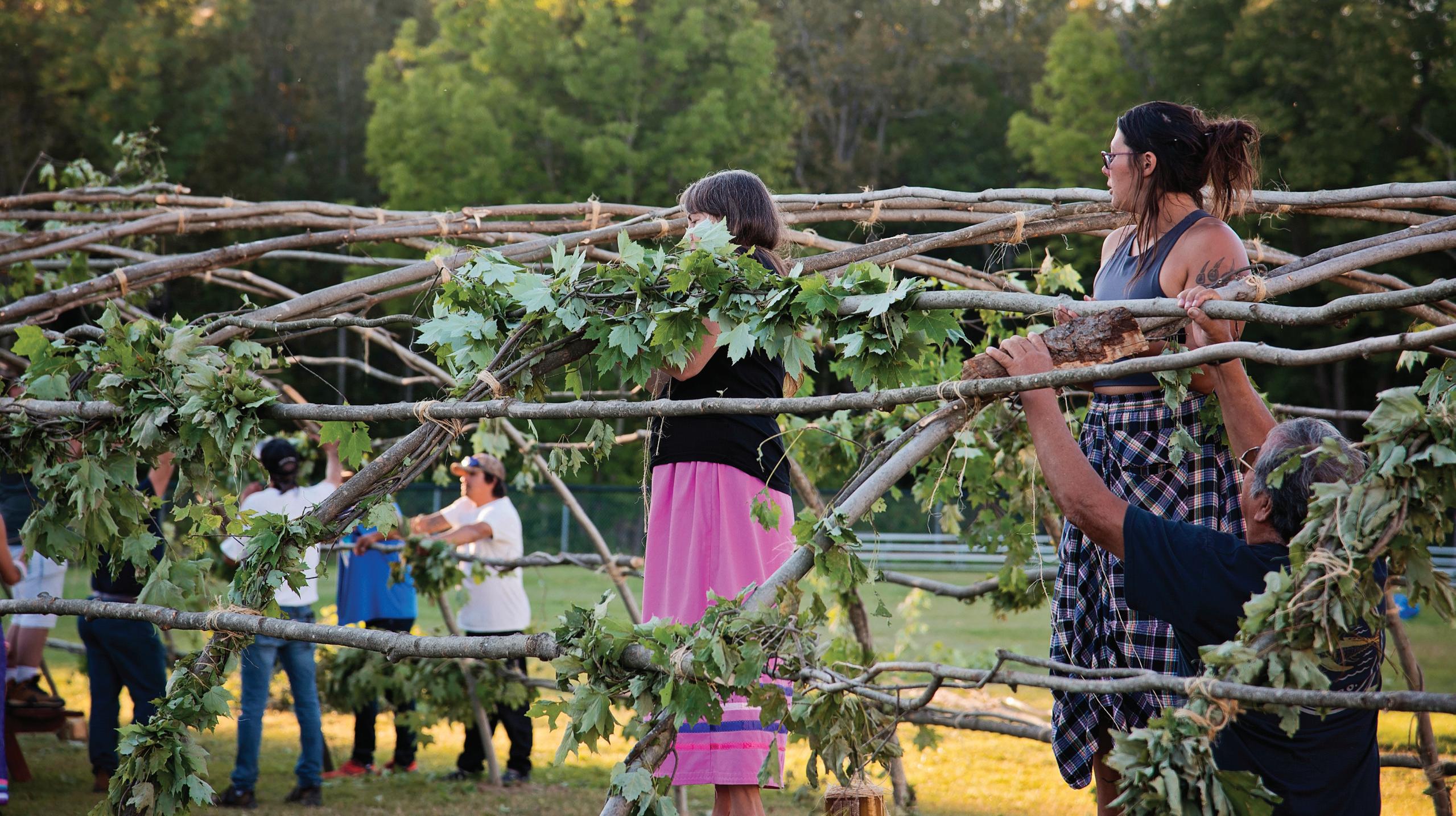
Working for my Band’s Lands office, I’ve witnessed a lot of changes in my homelands.
I’ve seen logging trucks hauling out timbers, mining trucks, and new cottages popping up along the shores—privatizing our territory and removing those lands from being accessible under our Treaty.
There was never very much consultation on these ‘land grabs’ and when there was, it was very short notice—too short to really assess the impact and inform our members enough to be able to effectively respond in time. When we did interject, we realized we were but a checkbox under the Consultation and Accommodation requirements of the Environmental Assessment process. The project for consideration was still going to happen regardless.
On an individual level, there was not much weight given to our community’s stance on proposed development in our territory. When we were able to prove a legitimate impact on our rights, the developers ‘mitigated’ but went on with it.
drafted, and I won’t be seeing my very valid concerns addressed in the final version. If you or someone you know works in Lands, I’m sure you share my frustrations.
The few times we have been able to have a stronger voice in the decision-making was when we have had solid evidence of our land use in a proposed development area. An example that I’ll offer was when we mapped out our youth canoe journeys. We would harvest berries and plant foods along the canoe routes and the forests adjacent to them. We objected to aerial spraying of herbicides and were successful in having those areas saved because they were cultural harvesting areas. The Forestry Planning team removed those areas from their aerial spray plan. A real win would have been to not have them spray anywhere in our territory but we were at least able to stop it in those areas because of the youth.
This made me realize how important of a tool Use and Occupancy Mapping could be in the protection of our lands and waters.
It has been a few years since I worked on the front lines in the Lands Department, but I still see the accelerated development of our surrounding territory and don’t get consulted often as a member.
Too many times I have felt hopeless going into a Ministry Engagement session knowing well that whatever feedback I provide is after the fact, the plan is likely already fully
There seems to be a growing threat to our homelands, as cities and suburbs fill up and sprawl out, with the need for new subdivisions, and increasing transportation and energy infrastructure. Resource extraction is at an all-time high with new mines, and water permits flooding the desks of our Lands people. Our whole territory seems to be under assault. Without organization, Anishinaabe Treaty Territory is at risk.
Enter the Robinson Huron Waawiindamaagewin (RHW), an initiative that was undertaken by the 21 First Nations of the Robinson Huron Treaty (RHT) to create a Treaty level body capable of addressing many issues that have, until this time, been addressed within Canadian government-
WHEN FIRST NATION LEADERSHIP HAS GOOD QUALITY MAPS TO TAKE TO NEGOTIATIONS, THE RESULT IS THAT THE NATION ENDS UP WITH A GREATER SAY ABOUT WHAT HAPPENS IN ITS HOMELANDS.
created agencies and systems of governance; and, to develop a collective Anishinaabe decision-making body progressing the interests and inherent rights of our people.
It’s easy enough to ignore one or two First Nations on a project, but how about 21 First Nations whose territory the proposal falls in? Call me naive, but I’m hopeful that we may now actually have a collective voice that gets heard and listened to.
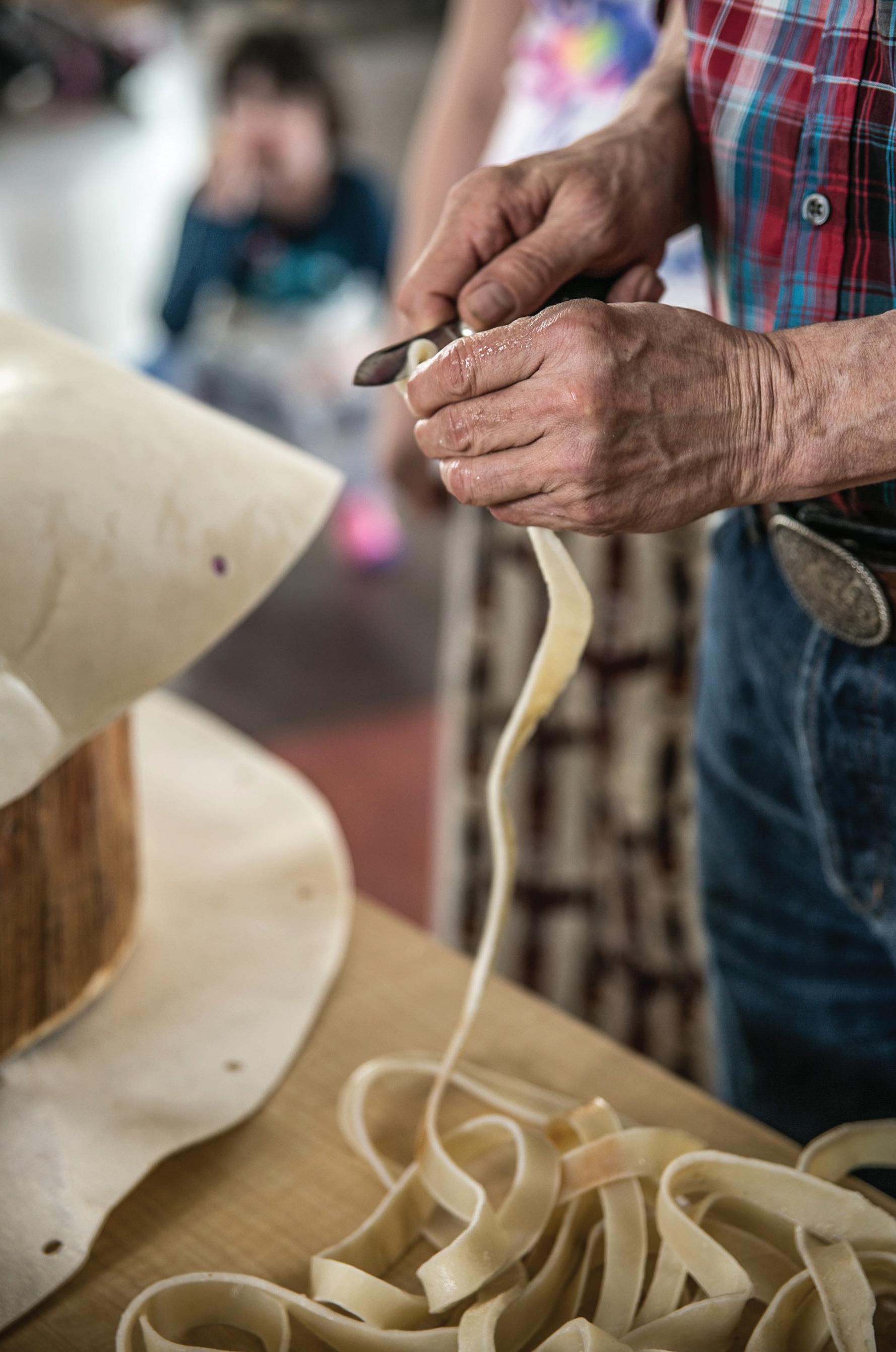
If we are going to approach things from the strength of the Treaty level, it only makes sense to start building up our collective tools. Back to the mapping, I was talking about earlier. We know how valuable Use and Occupancy research is in protecting Anishinaabe rights and interests, and monitoring the ecosystem within the Treaty Territory. But it will also be useful in our boundary assertions and dealing with overlapping jurisdiction, and can provide valuable evidence for litigation.
Any nation that does not have solid defendable maps is at a real disadvantage at any serious negotiation whenever a corporation, government agency, or even another Indigenous party wants to do something on or with their land that the First Nation opposes. When First Nation leadership has good quality maps to take to negotiations, the result is that the Nation ends up with a greater say about what happens in its homelands. Any community with robust maps will discover them to be an asset for all kinds of purposes in the coming decades.
So, the RHW has been directed by RHT Leadership to undertake a Treaty-wide Use and Occupancy Study. All RHT Anishinaabe harvesters whether they be hunters, fishers, medicine-gatherers, basket weavers, or berrypickers can contribute to this study by taking part in a map biography. Use and Occupancy Mapping tells the story of a person’s life on the land in picture form and is collected through interviews and map surveys. The study will include Anishinaabe who have extensive personal use of their homelands.
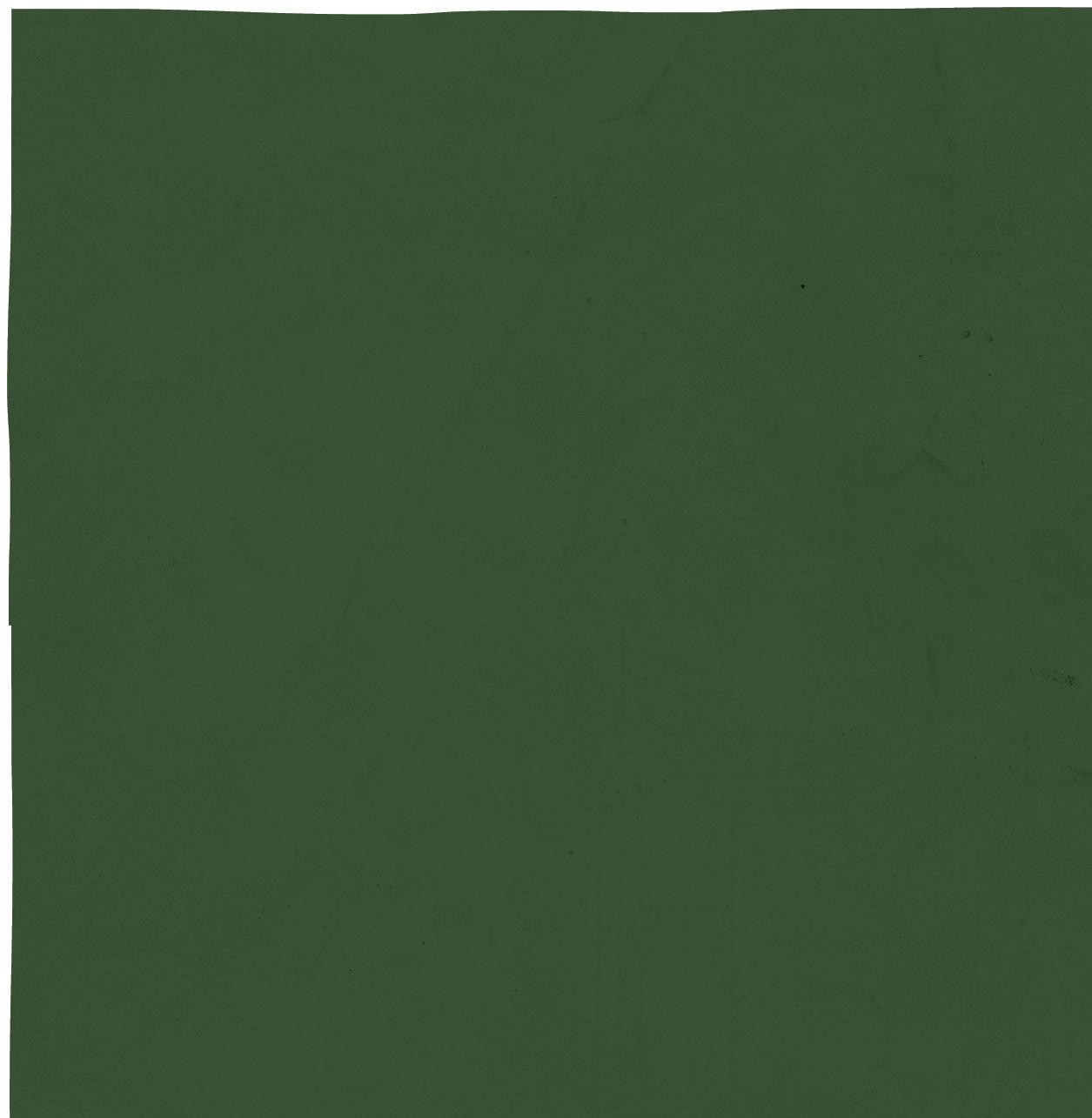
The Use and Occupancy data collected through these interviews will be crucial in asserting jurisdiction and protecting areas of Anishinaabe importance. The more participation we have, the stronger our research will be. We hope for your participation in this important project and look forward to seeing you in the community.
If you or someone you know is interested in participating in the Use and Occupancy Study, please contact:
Robinson Huron Waawiindamaagewin (RHW), in coordination with North Shore Tribal Council (NSTC), has taken the lead on the Treaty Curriculum project. Marnie Yourchuck was coordinating the project and felt that it was a natural fit for our newly formed Treaty Governing Body.
NSTC had begun the development of the Treaty Curriculum for schools in 2015 with the assistance of Dr. Pamela Toulouse. This included the development of Treaty units and outlines, and some lesson plans for grades kindergarten through to Grade 12.

RHW began coordinating the Treaty Curriculum project in 2021. We wanted to review the work by NSTC and get it classroom ready. Many amazing products and pieces were provided by NSTC. We needed to review these materials and determine how we get them into our schools. We wanted to ensure that the curriculum developed met current provincial guidelines so they would seamlessly integrate into community and provincial schools. We recognized that we would need some curriculum expertise on our team and reached out for potential support.
Mazkenzie Sayers was hired as our Curriculum Expert working directly with our Director of Research and Communications. Mackenzie has completed the review and developed recommendations for enhancements to improve ease of use for teachers and classrooms. Mackenzie will be now working on implementing her recommendations and developing Treaty Curriculum and resources for kindergarten to Grade 12. This project will be a multi-year project. We hope to have Treaty Curriculum available to teachers in the near future.
We are very excited about the Treaty Curriculum project and are happy to be working with Mackenzie and our leadership to develop these meaningful lessons. We are grateful to Marnie and NSTC for developing the vision of Treaty Curriculum and including the rich diversity of our Anishinaabe. Be on the look out for Treaty Curriculum in schools near you!
Robinson Huron Waawiindamaagewin
(RHW) is happy to announce that we have launched our Treaty billboard initiative. We started with 10 billboards being installed in the territory this summer. The billboards honour Anishinaabe Territory throughout Robinson Huron Treaty Lands.

The project began as a way to increase knowledge about Robinson Huron Treaty Lands. Nipissing First Nation and Dokis First Nation Gimaa Scott McLeod and Gerry Duquette, along with the RHW team and cultural advisors, unveiled the new billboards on Monday, June 27, 2022, at the Hwy 11 sign location, just north of North Bay. The event was marked with a Ceremony and celebration.
Earl Commanda, Executive Director of RHW, says, “These billboards and signage acknowledging our Treaty area is an initiative of RHW to foster significant historical recognition for settler citizens on the importance of the Robinson Huron Treaty of 1850. The billboards are also a reminder that our territory is protected by the Treaty with the Crown for our people as we continue to assert our rights to continue to hunt, fish, trap and gather—activities we have done since time immemorial for our sustainable development. The Treaty Territory signage is meant to create awareness for settlers and re-affirm our relationship to the land as the Creator instructed us to do based on our worldview and teachings.”
The messaging of our billboards was developed with our leadership and the design was created by our graphic artist Melanie Laquerre. We hope to honour our Treaty Lands by recognizing our territory. We started our project
with 10 signs throughout the territory and we hope to add more to our communities in the future.
We are also working on official highway signs. Our policy team is in discussions with the Ontario Ministry of Transportation (MTO) to have Robinson Huron Treaty provincial highway signs throughout Robinson Huron Treaty Lands.
These signs would be different from our billboards and would be similar to the blue official highway signs you see around Wahta Territory. Sam Manitowabi, our Senior Policy Analyst, has been coordinating the highway sign project. Sam says, “On a more serious note, MTO highway signs are important as they acknowledge our existence, that we are still here. The signs represent an opportunity for all travellers to know whose territory they are visiting or travelling through. For too long have we been ignored. If our existence is not recorded or acknowledged, it makes it easier to displace us, to encroach on our territory. We hope to see signage throughout our territory soon.”
If you have any ideas for billboards or sign locations, please contact Cheryl Recollet at cheryl@waawiindamaagewin.com. Gchi-miigwech.
Treaty education and engagement is an important aspect of the work done at Robinson Huron Waawiindamaagewin (RHW). Easing of public health restrictions has meant that RHW has once again been able to get out into communities to share Treaty knowledge with our community members.
Recently, the RHW team, including representatives from the Robinson Huron Treaty Litigation Fund (RHTLF), traveled to Garden River First Nation to share their knowledge of the Robinson Huron Treaty of 1850. This included Treaty history, pre-confederation to contemporary times, and a legal update from the RHTLF Annuities Litigation. RHW also brought their wampum belts with them to give an experiential learning opportunity to participants.
The team always welcomes requests to visit our Treaty communities to share our knowledge about the Treaty and about the work our organization has been doing. Please reach out to the RHW team for more information.
Read more about the Treaty Gathering on page 36.
Photo: Twenty-Four Nation Wampum Belt
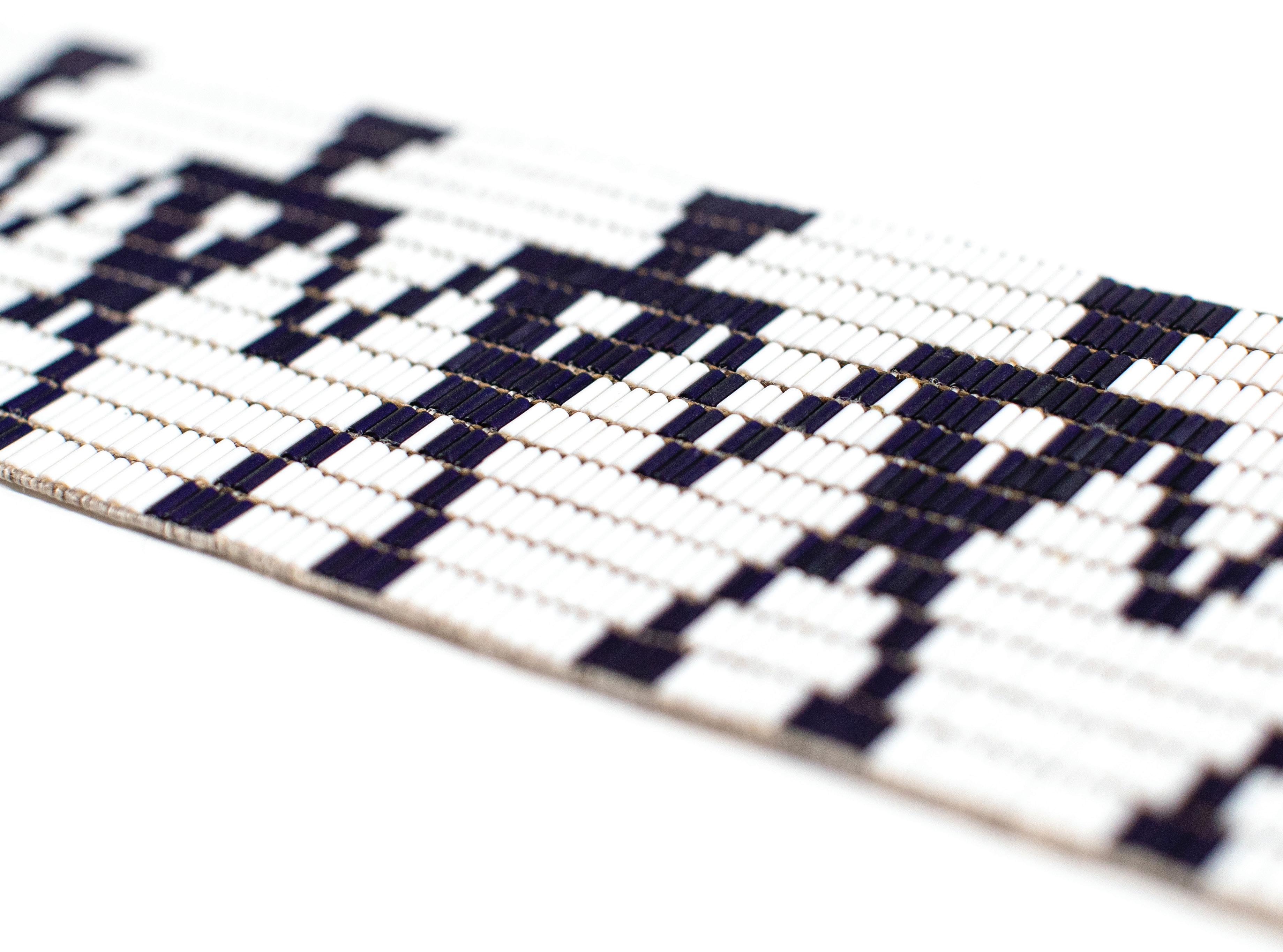


(RHW) is working on a Desktop Research Study in partnership with existing Tribal Councils, Unaffiliated and Large First Nation tech units to provide an inclusive look at Capital and Operations and Maintenance (O&M) needs for sustainable development and produce a usable report of findings for the communities extrapolating information from existing studies and data.
The intention is to produce a tool that communities can use in negotiating with government and funders, armed with information that illustrates the funding disparities we have been operating under for generations.
The Desktop Research Study was approved by Chiefs in assembly on March 10, 2022. This collaborative project will produce baseline data to support community, regional and Treaty-level planning and financial independence. The collaboration of Tribal Councils and Unaffiliated Communities will foster development of a thorough Treaty model that will inform key areas of interest and assist in coordination amongst RHW communities. It is an opportunity to develop trust and strengthen Anishinabek alliances and relationships.
Having built this into the organization workplan for this fiscal year, RHW has made presentations to the Northshore Tribal Council Board (NSTC), Waabnoong Bemjiwang Association of First Nations (WBAFN), United Chiefs and Councils of Mnidoo Mnising (UCCMM), Wiikwemkoong Unceded Territory and Serpent River First Nation. Future meetings will be scheduled with individual First Nation communities as requested.
The group has reviewed a proposal from the engineer, Guy Felio, and have met to discuss the methodology and parameters. The group has recommended that the engineer provide additional information to address potential gaps and non-participating communities. Guy Felio has many years experience working with First Nations and municipalities in the areas of Asset Management, Infrastructure Resilience and Climate Risk Assessments.
This project will move forward conducting a literature review of published reports and documents available through First Nations and other relevant public reports. A methodology will be developed based on previous studies and input from a technical working group comprised of representatives of the Tribal Councils, Unaffiliated and Large First Nations communities. This fall we will be engaging with First Nations on the collection of information and begin analyzing the data, followed up with additional community engagement as required. We expect a draft report to be complete by early December for the committee to review.
Upon completion of the study, the intention is to have a tool that communities will be able to use to assist in planning, budgeting and negotiating with the Crown to begin closing the funding gap that has been separating Anishinabek and Canadians.
On July 18, 2022, a group of researchers gathered in Killarney for 10 days of intensive Use and Occupancy Study (UOS) training with Terry Tobias and the Robinson Huron Waawiindamaagewin (RHW). Some participants came from as far as Australia, where the Indigenous people there have undertaken these studies to protect and further their rights and interests.
The focus of the interviewer training was the RHW’s UOS Data Collection Manual that was developed over the last two years through numerous research design workshops with Robinson Huron Treaty First Nations.
The RHW held seven in-depth workshops with land users in Phase 1 communities. The research design process was necessary to determine the questions that we put in our survey. The survey will be used for the interviews with our land users. During each workshop we reviewed the parameters of the projects—who are we interviewing, what (species) are we asking about, where on the land are we talking about, and when is the timeframe we are asking about.
In the testing phase, the methodology was stringently tested on 25 top Anishinaabe harvesters from the Robinson Huron Treaty territory. It was developed and refined to guide with precision to ensure the validity of the research and produce reliable, bullet-proof maps that won’t be rejected or discredited in even the most critical environments, like negotiation tables and courts.
A map will be only as good as the critical thought brought to bear in designing and running the project. The community’s own methodology will be described in a custom-written data-collection manual and the precise set of tools and conventions used will be determined by the unique context of the particular community and culture. – Living Proof byTerryTobias
As part of the training experience, Wiikwemkoong leadership brought the researchers out on the land, guiding them on a tour. It is important to introduce them to our territory, so they can understand what we are trying to protect. They had the
pleasure to visit pictographs, a wild rice bed, and a 1700s village site!
The Data Collection Manual was further enhanced through the process, having 15 sets of possibly the world’s most experienced eyes on it! The Robinson Huron Treaty UOS will be the largest regional UOS ever undertaken, using the top experts in the field.
We had participation in the training from some of our treaty neighbours in Saugeen, Nawash and Pic Mobert, who will also be undertaking Use and Occupancy Studies in their respective homelands.
Our survey and base maps have been finalized and we will begin interviews this fall. The first community that will be interviewed is Nipissing, starting in October 2022. They have demonstrated readiness, have a strong community coordinator that has compiled a robust list of willing participants from their First Nation.
Terry and his team will be going out to each of our communities to survey land users. The interview process will take roughly 1-3 hours and will be one-on-one. All COVID-19 precautions will be carried out. We are looking to identify names of people who should be interviewed. If you are interested or know a harvester who might be, please contact us.
If you are interested in participating and contributing to this important study, please contact Stefanie Recollet, Use and Occupancy Analyst at Stefanie@waawiindamaagewin.com
As part of the training experience, Wiikwemkoong leadership brought the researchers out on the land, guiding them on a tour. It is important to introduce them to our territory, so they can understand what we are trying to protect.


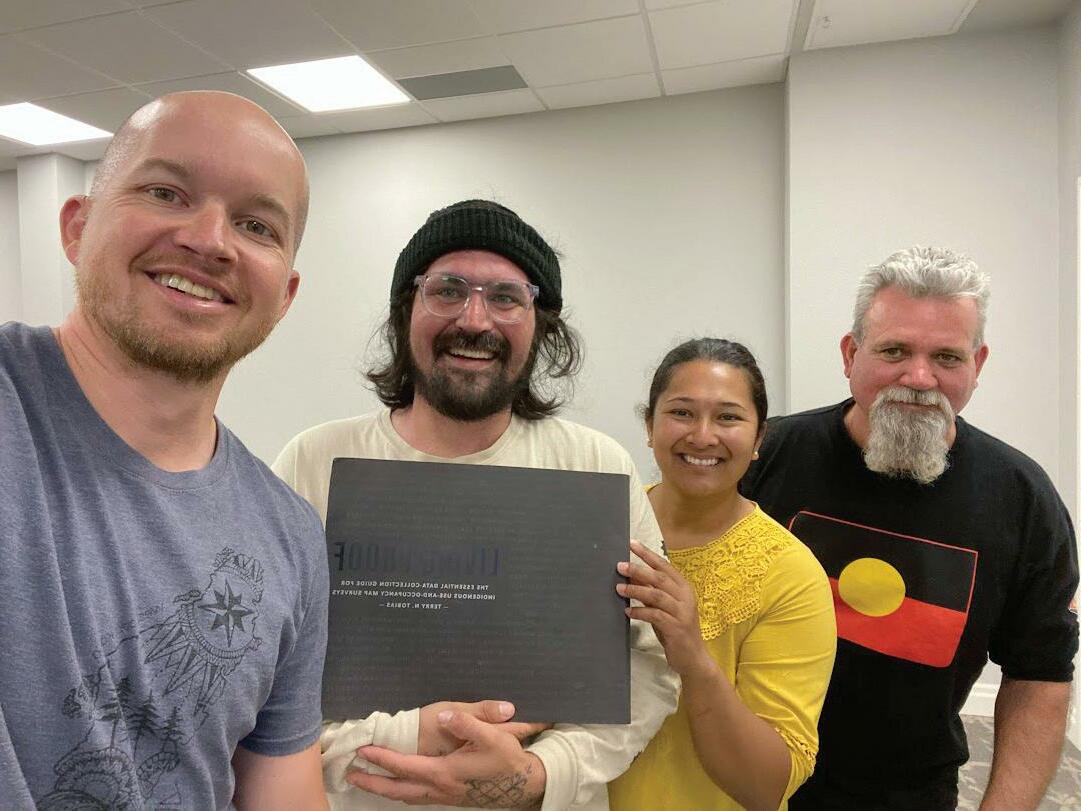

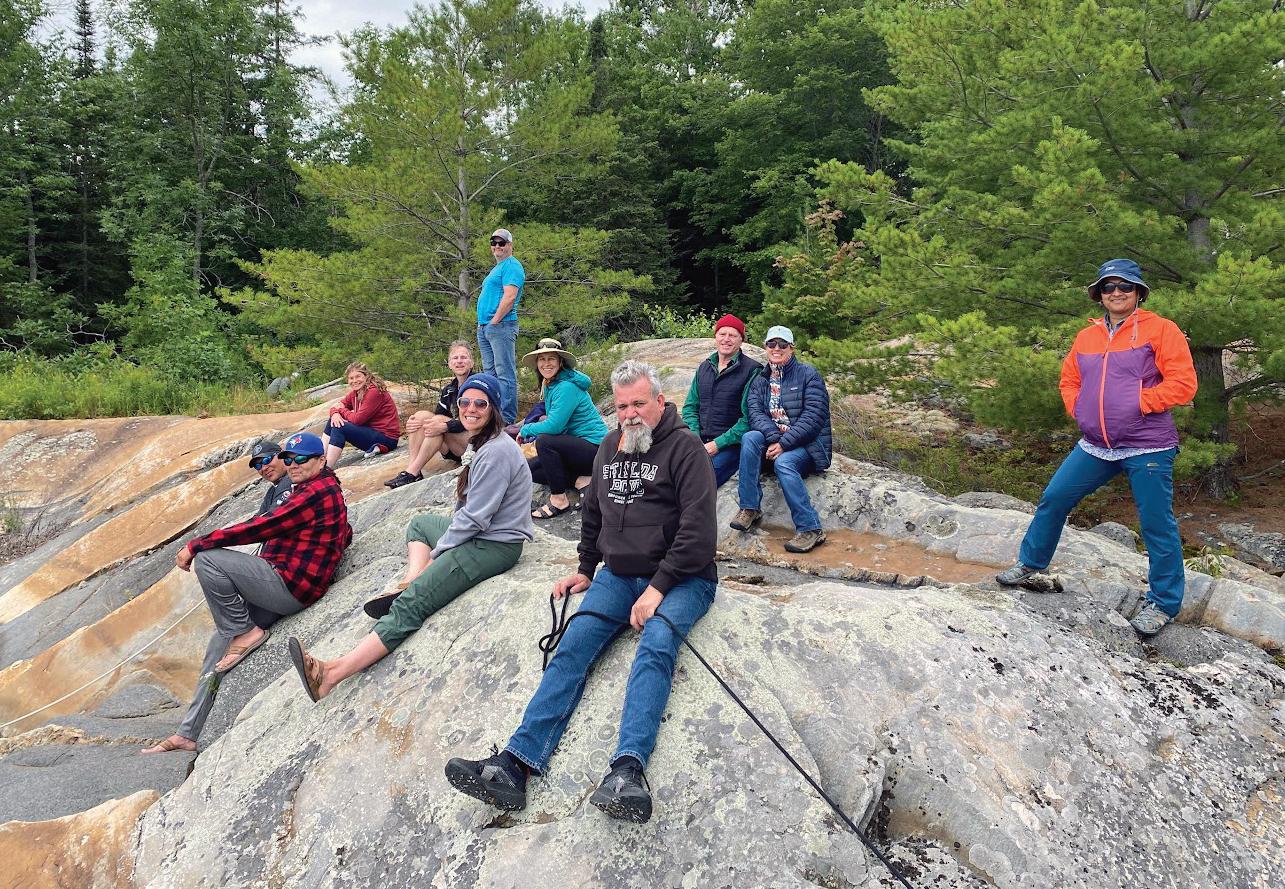
 By Steven McCoy
By Steven McCoy
Since 2016, the Robinson Huron Treaty First Nation communities have organized and hosted an annual Treaty Gathering to commemorate the signing of the Robinson Huron Treaty that took place on September 9, 1850, between the 21 Lake Huron First Nation communities and the British Crown, which at the time, was the governing body that oversaw what is now known as the country of Canada.
The Robinson Huront Treaty (RHT) of 1850 Treaty Gathering started as a way for the Treaty communities to exert their sovereignty over their traditional territory, gather strength and guidance from the ancestors, and, most importantly, raise awareness amongst Indigenous and non-Indigenous communities about the RHT of 1850 and provide updates about the current litigation taking place before the courts.
The two organizing bodies of the RHT communities are the Robinson Huron Waawiindamaagewin (RHW), which is responsible for the bringing together the cultural aspects of the Treaty communities and the Robinson Huron Treaty Litigation Fund (RHTLF), which is responsible for overseeing the legal aspects of the current court case against Canada and Ontario. Both organizations work closely together when organizing the annual RHT of 1850 Treaty Gathering.

THE 2022 RHT GATHERING WAS TITLED ‘RESTORING THE BALANCE’ AND ORGANIZERS EMPHASIZED A LOT OF ATTENTION TOWARDS BRINGING IN ELDERS TO SHARE THEIR TRADITIONAL KNOWLEDGE, PARTICULARLY WITH THE YOUTH FROM AROUND THE REGION THROUGH HYBRID FORUMS OF IN-PERSON AND ONLINE DISCUSSIONS.

Each year the RHT of 1850 Treaty Gathering has grown in all aspects and offered some truly unique content for those in attendance, and the 2022 gathering was no different. This year’s gathering provided attendees with all kinds of engaging content including traditional ceremonies, branded apparel, cultural offerings, valuable knowledge and opportunities to connect with others from across the region.
Along with engaging content, attendees were also treated to delicious meals provided by Hiawatha’s Catering, a local award-winning Anishinaabe food catering company founded and run by Hiawatha Osawamick from Wiikwemkoong Unceded Territory.
The 2022 RHT of 1850 Treaty Gathering was hosted in the community of Nipissing First Nation from September 7 to 9 with Dokis First Nation taking the co-host duties due to their close proximity to Nipissing First Nation. The theme was Restoring the Balance and organizers emphasized a lot of attention towards bringing in Elders to share their traditional knowledge, particularly with the youth from around the region through hybrid forums of in-person and online discussions.
A lot of preparation goes into organizing and executing an event of this size and the 2022 RHT of 1850 Treaty Gathering was no exception. One of the major tasks that was introduced at the 2021 gathering was the building of a Teaching Lodge to incorporate more traditional culture and knowledge into the gatherings.
The 2022 lodge assembly team, which consisted of workers, volunteers and youths from the local community, along with guidance from Elders, went out into the bush surrounding the local area and harvested the proper saplings required for the construction of the lodge.
The weather was warm and sunny as the assembly team spent the entire two days before the start of the gathering, harvesting the proper materials and constructing the lodge in the field just behind the rink complex and beside the administration buildings located at 36 Semo Road in the heart of Nipissing First Nation, also referred to as Garden Village.
The start of the 2022 RHT of 1850 Treaty Gathering began on the morning of Wednesday, September 7 with a Sunrise Ceremony at 5:30 a.m., just as the sky in the eastern horizon was starting to turn from black to pink as the sun began to make its daily presence known.

The early morning dew was heavy on all things as the overnight temperatures dipped down to a cool 8 degrees Celsius but as the day began, the temperature started to stubbornly rise. The chilly morning temperatures did not deter those from attending ceremony as the Teaching Lodge was filled with approximately 50 individuals, all from various ages, genders, cultures and creeds from across the region and Treaty Territory.
The lodge was an impressive sight once completed as it stretched over 125 feet in length and the pride it brought to those involved in the building process was clearly visible in their faces and body language.
The incredible number of people in attendance for Sunrise Ceremony did not go unnoticed by the Elders and speakers as they all mentioned how lovely it was to see such a great turnout of attendees in the early morning hours. Many of the Elders and speakers commented that they had never seen so many people at a Sunrise Ceremony before as they took turns speaking and sharing their knowledge. The extraordinary number of attendees present for early morning ceremonies was an initial indication of what the attendance numbers would be like over the next few days.
THE EXTRAORDINARY NUMBER OF ATTENDEES PRESENT FOR EARLY MORNING CEREMONIES WAS AN INITIAL INDICATION OF WHAT THE ATTENDANCE NUMBERS WOULD BE LIKE OVER THE NEXT FEW DAYS.
As the morning ceremonies wrapped up, attendees began making their way over to the gymnasium complex, where Hiawatha’s Catering was serving up breakfast, while meeting and greeting with each other throughout.

As the morning continued, the crowd size started to swell as more and more delegates began to arrive in the heart Nipissing First Nation to take in the gathering’s events. Some attendees even arrived in chartered buses and coaches that shuttled in community members from other First Nation communities and youths from various schools. As in the past, organizers provided video and online streaming services to accommodate those who could not attend the gathering in person.
The main area where speakers and attendees gathered for the workshops and presentations was in the covered outdoor rink complex located beside the Nipissing First Nation administration buildings. The south end of the arena was prepped with the stage complete with lighting and a large video screen for the backdrop. The north end had a gallery setup with historic facts and pictures from the local First Nation communities complete with artifacts, large posters and popup banners featuring famous local Anishinaabe community leaders from the past and present.
As the first day of the RHT of 1850 Treaty Gathering continued, organizers handed out over 350 free hoodies and T-shirts branded with the Robinson HuronTreaty of 1850 logo to delegates, many of whom were the youths and Elders in attendance. Organizers of the gathering utilized the services of a local Indigenous business called Green Medicine by the Homeopathic Pair to supply apparel for attendees which was a highly sought after by all. For those who did not receive any apparel, they can still go online to Treaty1850store.ca to purchase their very own gear anytime.




As the afternoon sun warmed the grounds, the estimated crowd size had grown to about 400 people. Hiawatha’s Catering continued to provide lunches and suppers for the large number of guests in attendance despite having only planned to provide food for 250 people. The organizers and caterers managed to go above and beyond those numbers and fed more than 400 people for most lunches and suppers.



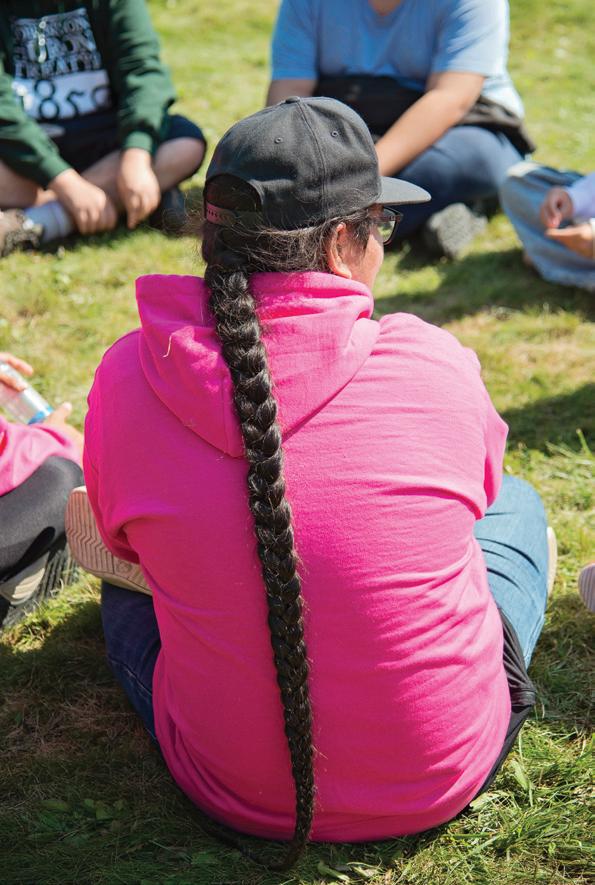


The good energy that started the day continued into the evening as activities wrapped up with delegates being treated to an ‘Open Mic Night’ session that featured some local talent hitting the stage strumming their guitars and showing off their vocal acumen for the crowd.

Performers included Deputy Gimaa Mike Sawyer and local legend and Gimaa Scott McLeod of Nipissing First Nation who started the night by showing off his guitar picking and singing talents for the audience. As day one ended, organizers and attendees were elated from the day’s events and there was a sense of excitement amongst the crowd for what tomorrow would bring.

The second day began with the customary Sunrise Ceremony which took place with much of the same weather and attendance numbers as the first day. Again, many of the Elders and speakers commented on how happy they were to see so many people up early and in attendance for ceremony so early in the morning.
After breakfast, welcoming remarks were given by Mike Restoule, Chair of the RHTLF, and Earl Commanda, Executive Director of RHW. The crowd was then treated to an impressive lineup of well-educated Anishinaabes and presenters including Dr. Alan Corbiere, Dr. Deborah
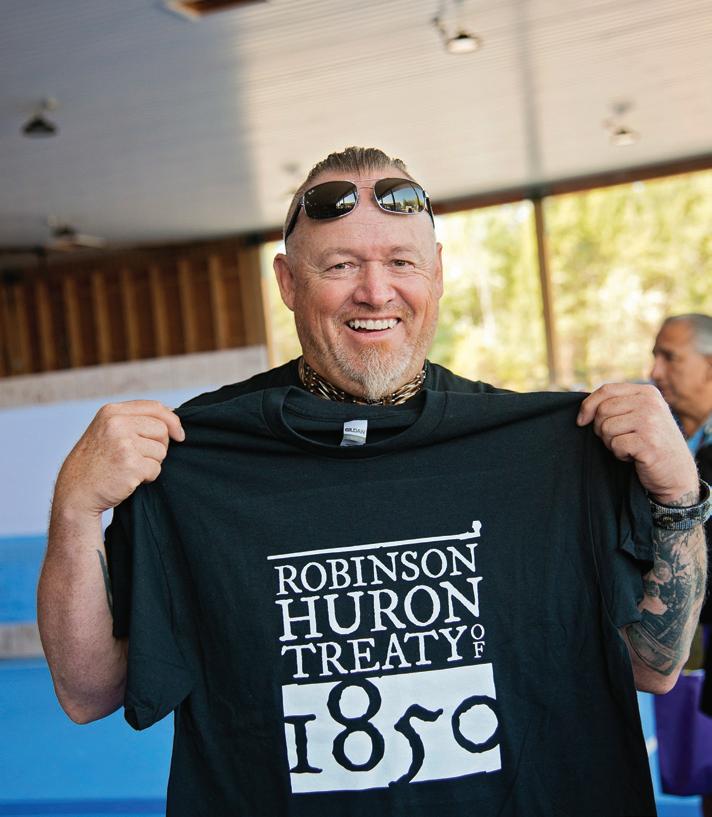
McGregor and Dr. Hidi Bohaker who all shared what traditional knowledge and governance means to them.
After lunch was served and people began to gather again in the main area, some sombre news began to spread amongst the crowd: Queen Elizabeth II, the very Treaty partner the RHT communities signed into agreement with, had just passed away.

The news of the Queen’s passing was a notable moment for the Indigenous members in attendance, as well as across the country. Mixed emotions ran through the crowd as some felt a loss and sorrow over the death of such a significant figurehead while others were defiantly joyous as the Queen’s death represented a form of reckoning for all the trauma the Crown’s policies inflicted upon Indigenous people across the globe.
Despite all the emotions, both negative and positive that the Queen and her death elicited from the crowd, despite all the traumas inflicted upon Indigenous people by the Crown and its policies of assimilation, and despite the fact the treaties have not been properly honoured by the Crown or succeeding governments since they were signed, the Indigenous leaders, organizers and most attendees still took the time to pay their respects.

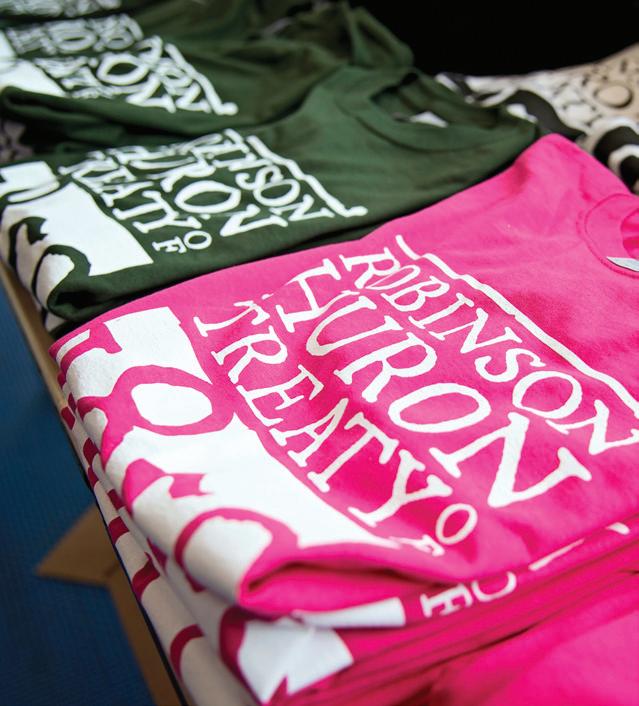
Before the start of the afternoon sessions, community leaders Nelson Toulouse and Phil Goulais, notified the crowd about the passing of the Queen and asked attendees to rise for a moment of silence to honour the Queen’s passing and recognize the importance of their relationship with their original Treaty partner. It was an extraordinary and sombre moment for everyone present which showed the respect Indigenous people carry for others while unknowingly displaying their own resiliency.

As the afternoon events for day two got underway, crowds of people from across the region continued to stream through the grounds, putting some strain on the resources and the organizers. As the RHTLF Legal Team gave their updates to the crowd during the afternoon, organizers worked with their caterers and local suppliers to ensure they had enough food to feed everyone for supper, especially the Elders. Supper was provided by Bear’s Fish Fry on Thursday and there were approximately 230 Elders who got fed, along with the rest of attendees those who stayed for supper.
Thursday evening entertainment was a comedy show suitably titled ‘Got Land?’, which featured Indigenous comedians Patrick Cheechoo, Mike Bombay, Dan Guiry, Lena Recollet, Clint Couchie and Janelle Niles. The comedians had the crowd rolling with laughter with their edgy humour and no-one was off limits to their roasting as Gimaa McLeod was fondly given a new nickname by one of the comedians: Stone Cold Chief Austin. With plenty of belly laughs and playful jokes, day two of the 2022 RHT of 1850 Treaty Gathering came to a satisfying close with everyone in high spirits.
On Friday, September 9, the third and final day of the gathering got underway as usual with a Sunrise Ceremony. Again, approximately 50 people were present in the Teaching Lodge on the final day as the high level of engagement by attendees was remarkable.



On the final day of many events, crowd size tends to diminish as people make their way home early but the high turnout of people for Sunrise Ceremony on days one and two continued into the final day, much to the surprise of the Elders and leaders who, once again commented on how nice it was to see so many people in ceremony so early in the morning.
As September 9 is the anniversary date of the signing of the Robinson Huron Treaty of 1850, the organizers
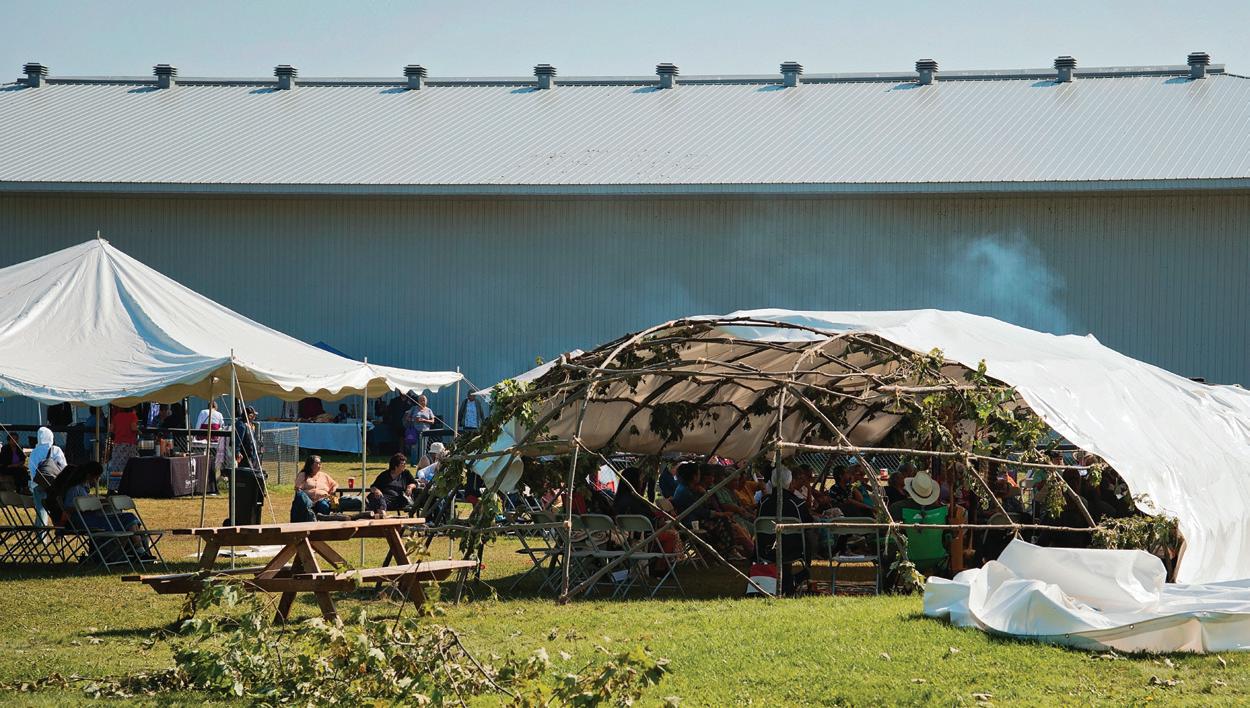
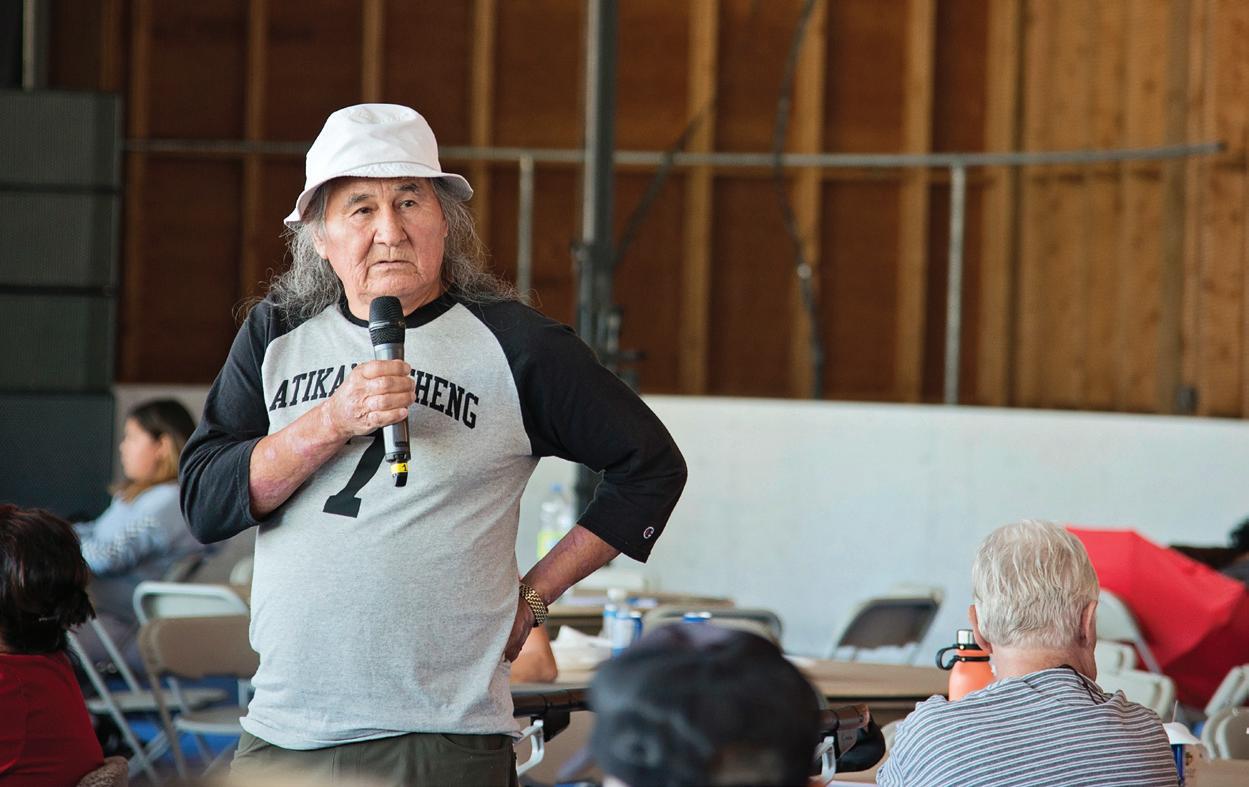
decided to dedicate the entirety of the day to be spent in the Teaching Lodge and the energy and excitement created amongst the attendees throughout the week was palpable in the air as events wrapped on Friday.
Organizers wanted to focus on having Elders and youths get together for the 2022 RHT of 1850 Treaty Gathering and the number of attendees proved their efforts were certainly an overwhelming success. Many people in the crowd commented on the number of Elders who were present and that it really felt more like an Elder’s Gathering, which was a welcomed revelation and testament to the organizers ability to bring everyone together and promote the event beforehand. One person who organized an Elder’s Gathering in the region, said they only had about 100 Elders present compared to the RHT of 1850 Treaty Gathering which had close to 250 Elders in attendance.
There were also approximately 75 youths in attendance from local schools who were bussed in from across the local region to take part in the gathering and to learn cultural knowledge and technical facts from the Elders, leaders and presenters. Overall, organizers estimated that approximately 600-700 people came through the gathering at some point over the entirety of the three days.
One of the teachings that a Gimaa shared spoke about how things go away if we do not use them or call upon them. For example, traditional ceremonies and gatherings were taken from Indigenous people over the years through colonialism and those things went away as they were used less and less. Along with those ceremonies, all the things that came with them also went away as they were called upon less and less over the years.
But recently, as those ceremonies, and connections with the land are used more and more once again by Indigenous people, things begin to return, whether they be the spirits, the animals, the lodges, the ceremonies, the teachings, the people, etc., the more certain things get used, the more they appear. As the Teaching Lodge gets used more and more, the lodge itself and everything that it brings with it, appears more and more.
After the last days events wrapped up, local community leaders, persuaded by the youth, asked the organizers of the gathering to leave the Teaching Lodge complete for a while longer because it was wanted and needed in the community. So, they agreed, and left the lodge intact for a while longer as requested.


As the 2022 RHT of 1850 Treaty Gathering wrapped up, the energy created, the knowledge shared, the connections made, and the gifts traded will be remembered by those who experienced it and those good vibes will carry into next year’s gathering, spreading to more and more people and will hopefully continue for as long as the Robinson Huron Treaty exists.
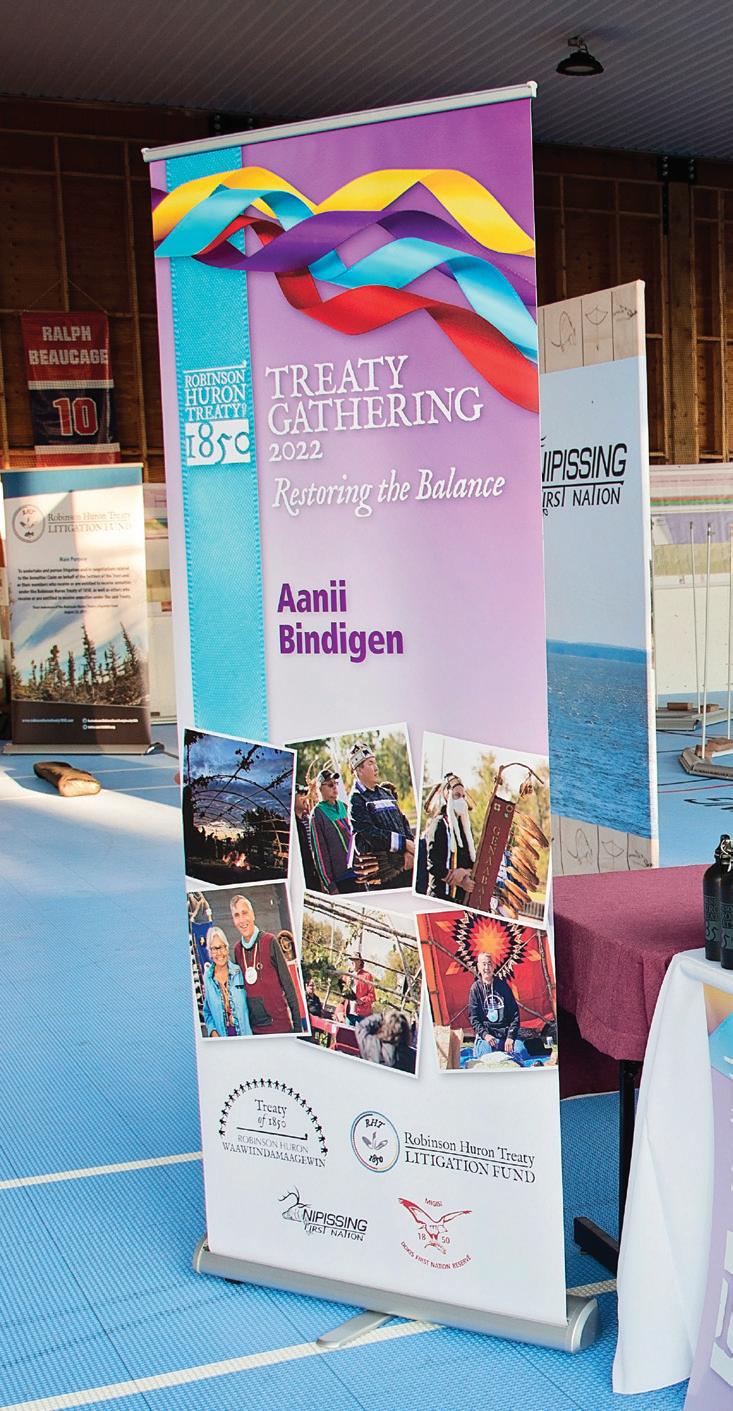
AS THE 2022 RHT 1850 TREATY GATHERING WRAPPED UP, THE ENERGY CREATED, THE KNOWLEDGE SHARED, THE CONNECTIONS MADE, AND THE GIFTS TRADED WILL BE REMEMBERED BY THOSE WHO EXPERIENCED IT.
In May 2022, the Robinson Huron Waawiindamaagewin team was invited to attend the community welcoming ceremony for the 1836 Treaty Pipe. Hosted by the Ojibway Cultural Foundation in M’Chigeeng, this event featured a talk from Wiikwemkoong Ogimaa Duke Peltier and was the last in their speaker series Ezhi-Zhinoomaading Mshkiki
Genaajiwong Waabnjigaade, Seeing the Beauty of Our Medicine. Seeing the Beauty of our Medicine is a series of talks centred on our medicines and gifts as Anishinabek to remember, honour, celebrate, heal, and move forward.
During his talk, Ogimaa Peltier shared his knowledge of various sacred items and the roles that they have played in our history. The evening included the welcoming of The Treaty Pipe of 1836 back to Manitoulin Island. Along with other gifts, this pipe was presented to the Lieutenant Governor of Upper Canada, Sir Francis Bond Head, when the Anishinaabe and the Crown made the Treaty of Manitowaning in 1836. The pipe has never returned to the territory since that time.
DETERMINED TO GET THE PIPE BACK, WIKWEMKOONG WORKED WITH THE ROYAL ONTARIO MUSEUM (ROM) TO PREPARE A FUNDING PROPOSAL TO SECURE THE PIPE DURING THE BIDDING PROCESS.
The Treaty was an agreement between Sir Francis Bond Head and the Anishinaabe after a failed experiment to “civilize” the Odawa and Ojibwa peoples already on the land. Bond Head believed that the Anishinaabe were doomed to extinction as a result of European colonization and that they should settle on Manitoulin to live until that time. In return, the Crown would recognize the Anishinaabe right to Manitoulin Island. This Treaty was broken 26 years later when the Crown took most of Manitoulin Island except for Wiikwemkoong Unceded Territory and a few other reserves.
In 2017, the pipe was listed for auction in San Francisco with Bonhams. Bonhams is a privately owned international auction house. Founded in 1793, it is one of the world’s largest and most renowned auctioneers of fine art, antiques, motor cars, and jewellery. Robinson Huron Treaty Litigation Fund (RHTLF) researchers found this auction listing and notified Ogimaa Peltier and Wikwemkoong.
Determined to get the pipe back, Wikwemkoong worked with the Royal Ontario Museum (ROM) to prepare a funding proposal to secure the pipe during the bidding
NOT ONLY IN CEREMONY BUT ALSO IN TALKS WITH OTHER NATIONS TO OPEN DISCUSSIONS IN A GOOD WAY. THE PIPE WAS A PART OF EVERYTHING WE DO AS ANISHINAABE.
process. They also committed their own funds if funding from the Crown was not sufficient. The lot was removed just before the auction, and the seller agreed to a private sale to Wiikwemkoong.
The pipe was then transported to the ROM where it had to be isolated for six months from the rest of their collection so that it could not potentially contaminate other pieces. The pipe continues its journey at the ROM to ensure that it is properly stored to prevent decay and disintegration with further age.
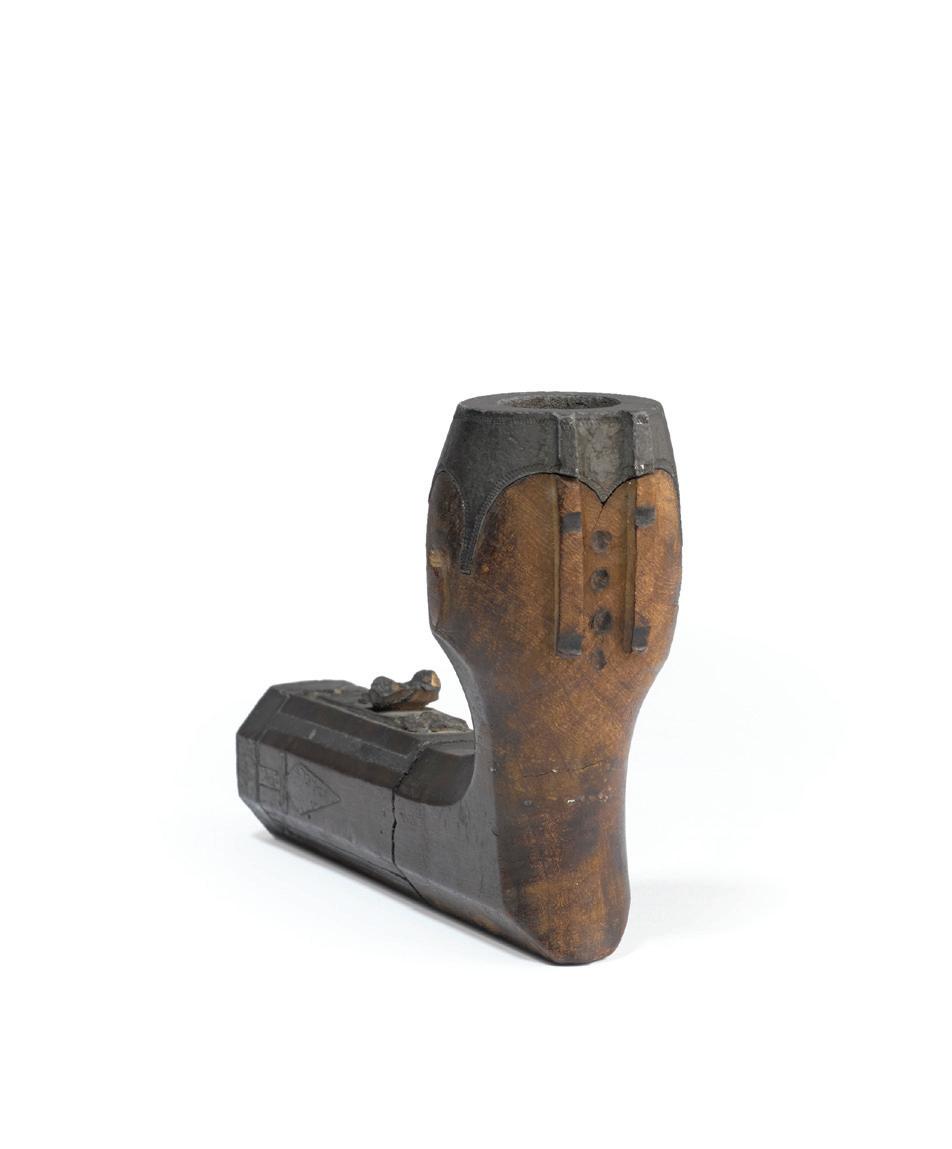
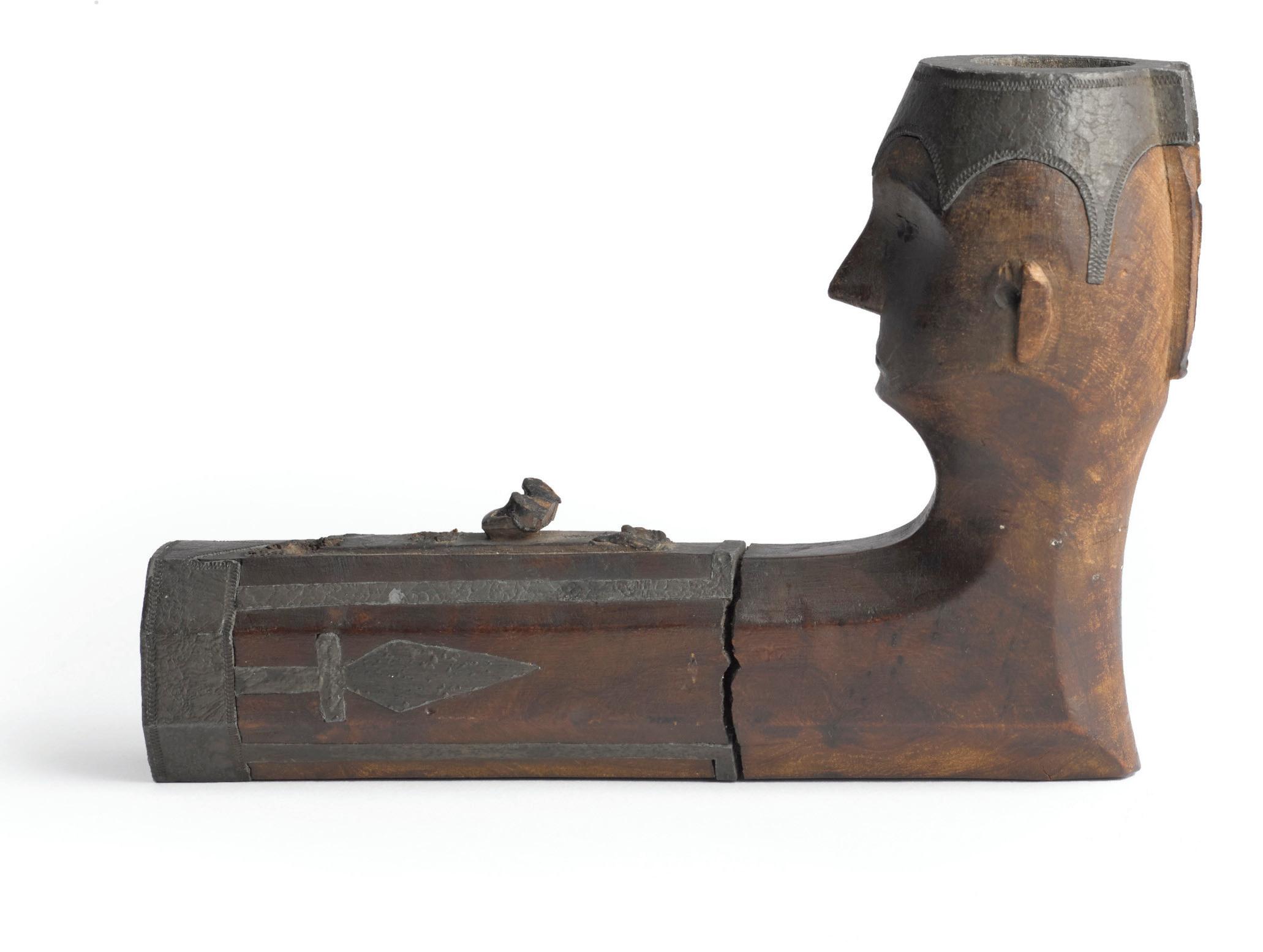

These events happened amid the COVID-19 pandemic. This caused a delay in the pipe returning to the Manitoulin Island communities. When the pipe finally returned, it was brought into Ceremony and feasted.
Pipes are significant, not only in Ceremony but also in talks with other Nations to open discussions in a good way. The pipe was a part of everything we do as Anishinaabe. It is a way of connecting to the Creator and our Ancestors, connecting to our spirituality. The pipe has a role in every Anishinaabe group, including the Midewin and Three Fires Confederacy.
Pipes are
significant, not only in Ceremony but also in talks with other Nations to open discussions in a good way.
THE PIPES ARE SIGNIFICANT,Photos by Bonhams.
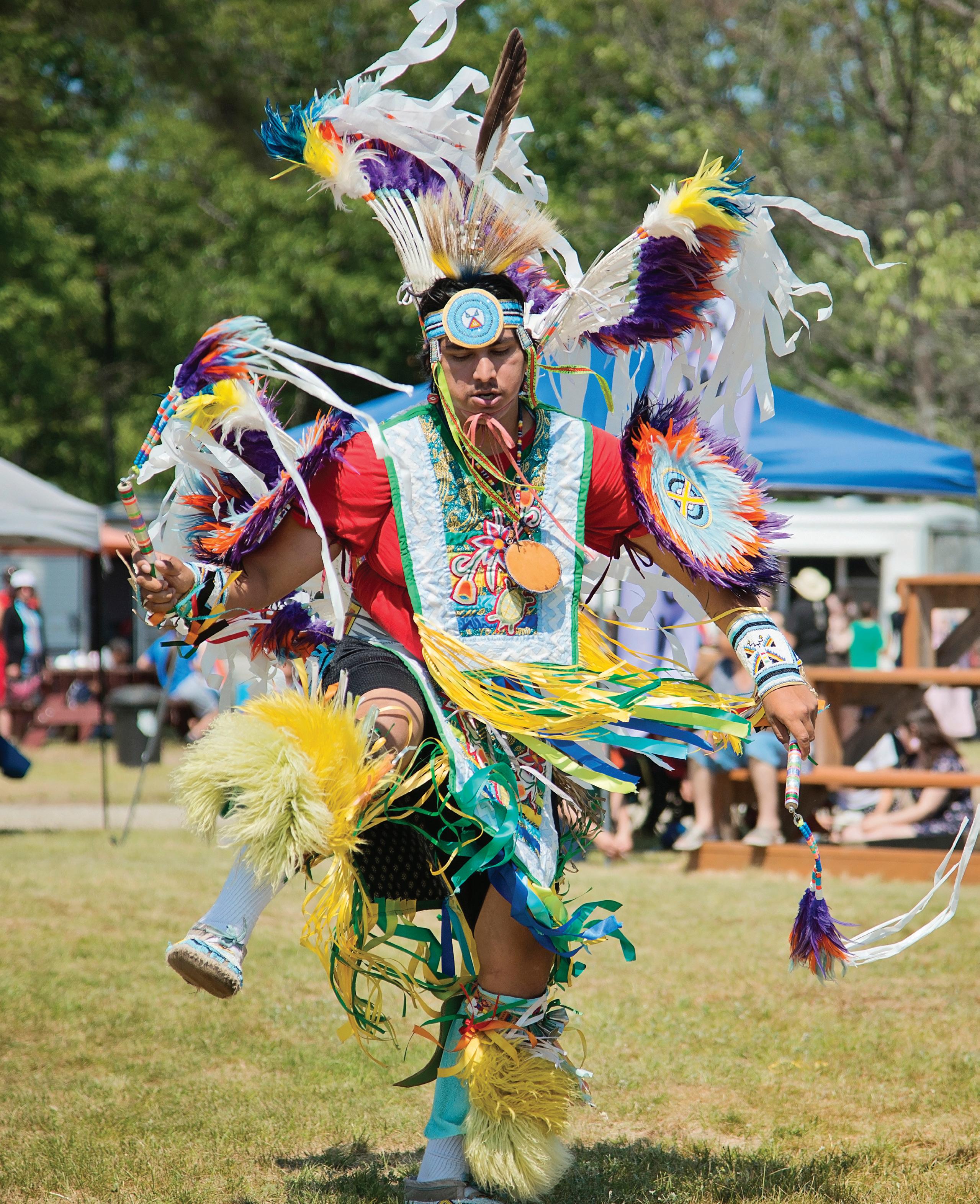








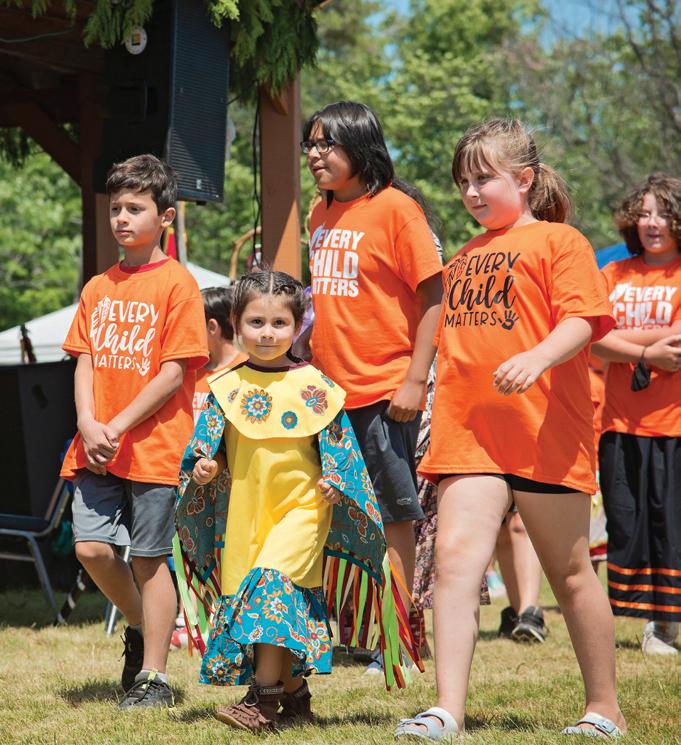



Anishinaabe from across our territory flocked to our gathering grounds to share and celebrate with one another. Our community powwows have been deeply missed over the last two summers and came back with strength and honour. The powerful drums, the beautiful songs, the mesmerizing dances, and the delectable eats make our powwows so exceptional. The most amazing part, however, is the laughter and love felt all through the grounds—the kids running around, the aunties visiting, the uncles watching, and the Elders sharing make it such a special place. Powwows were happening all across the North Shore, on Manitoulin Island, down the Highway 69 South/400S corridor, finishing off the season in Batchewana and Nipissing! The RHW team hosted an information booth at many of the gatherings this summer and was able to provide some swag and promotional items to share about our Treaty. We look forward to attending many more community events in the future. Gchi-miigwech for a remarkable powwow season!

Photo locations and credits: Sagamok First Nation (Melanie Laquerre), M’Chigeeng First Nation (Gloria Oshkabewisens-McGregor), Wahnapitae First Nation (Samantha Tyson), Wiikwemkoong First Nation (Hiawatha Osawamick, Elizabeth Eshkibok-Trudeau)


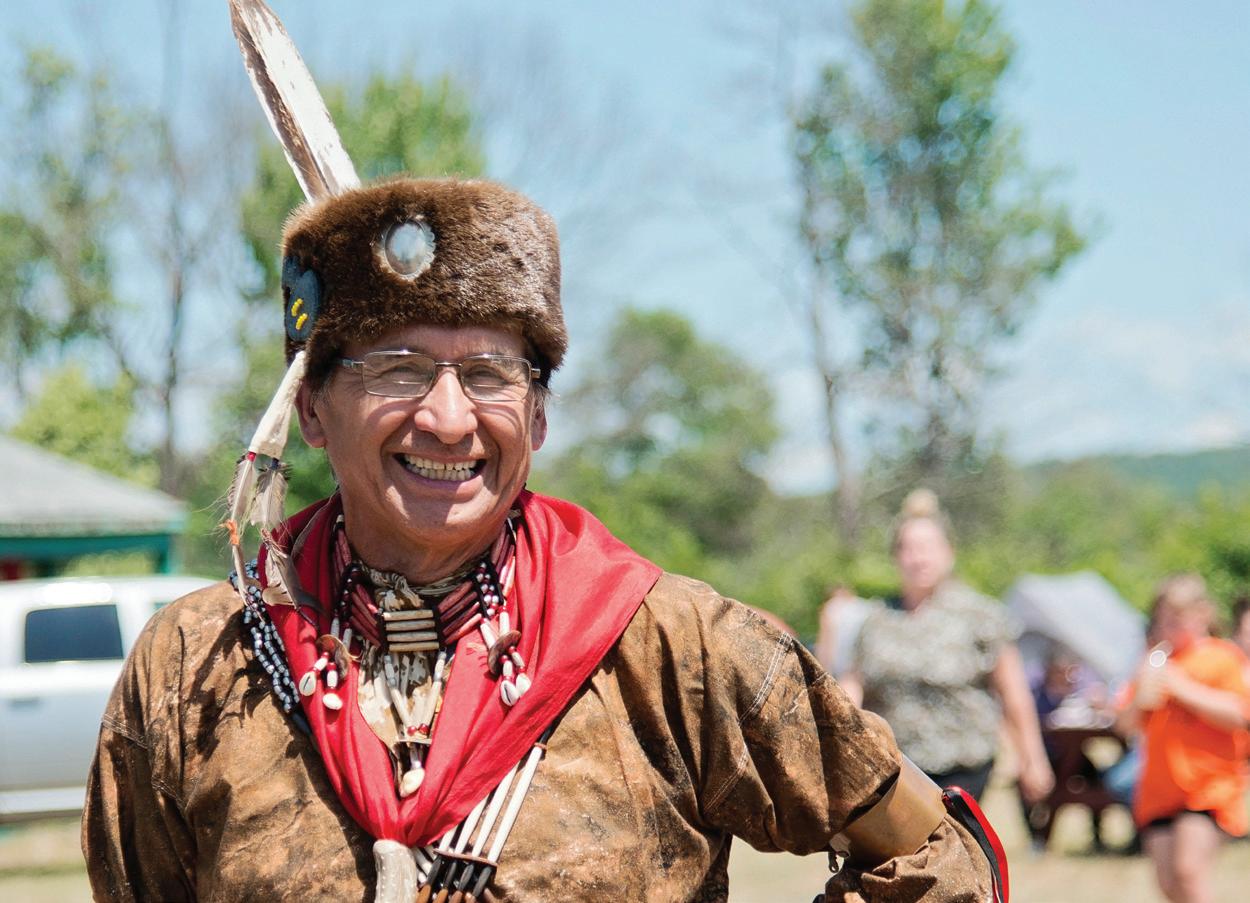



Summer 2022 proved to be an exciting one for powwow goes across Robinson Huron


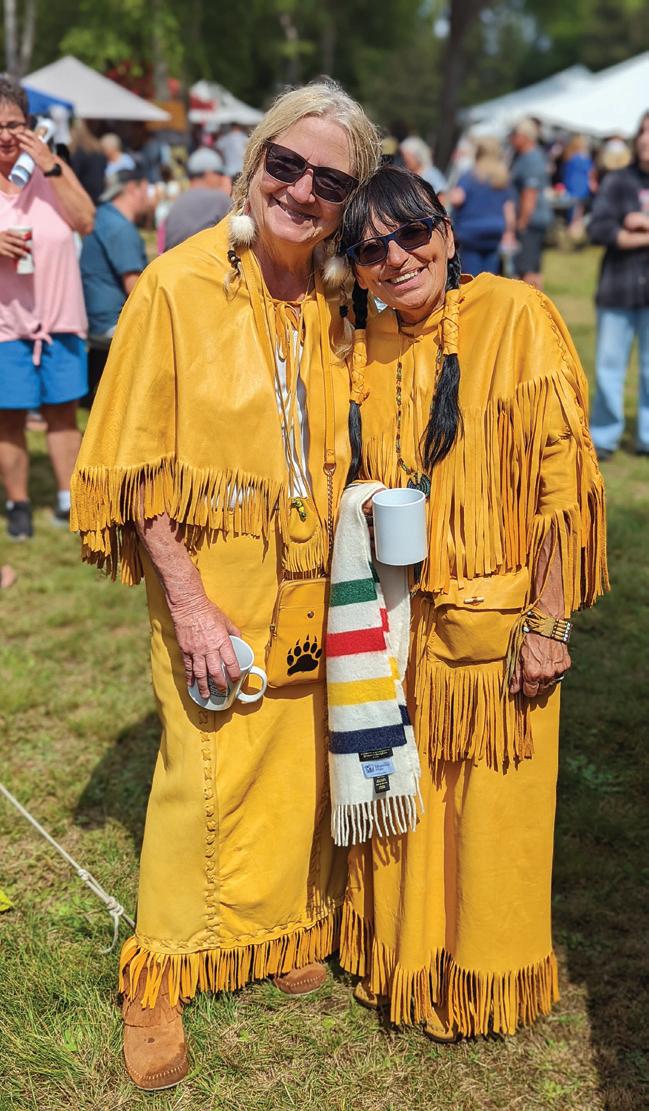





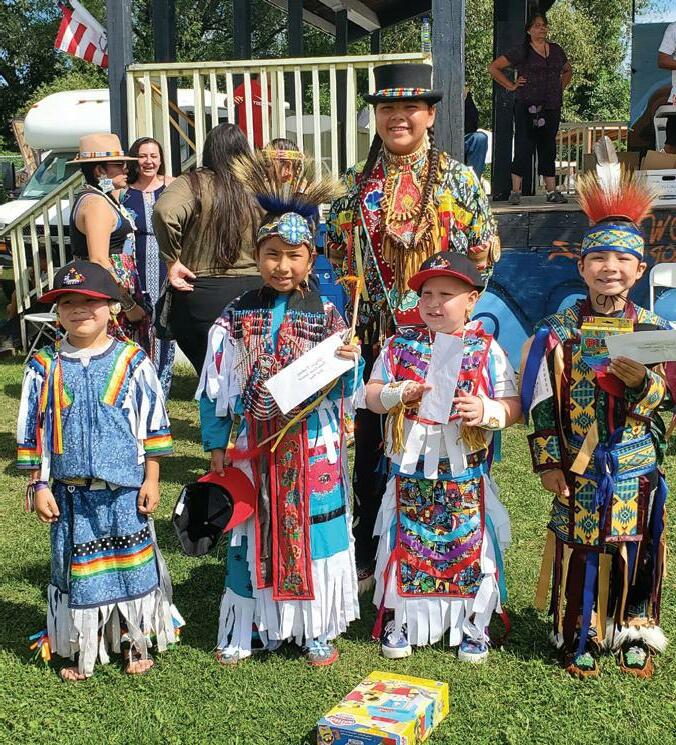

The term ‘Cartographic Cancellations’ in this case is specific to our Anishinaabemowin names of places being erased from or not even placed on the map. The importance of this specific ingenuity is for Neyaab Gweknikaadandaa, meaning Let’s Change the Name Back.
Here we introduce a new way of visualizing places through mapping and give you this understanding from the knowledge of our relations and history through the Anishinaabe lens.

With the contributions from our historian’s great work, we are working together with Robinson Huron Waawiidamaagewin (RHW) to build a web-based application based on the research being done for our Treaty and sharing place names and stories through cartographic publishing technology. The intention is to develop a digital atlas that is shareable with others and anticipate its use in educational systems to share Our Story, Places, and Sacred Ways.
Introducing our Historian, Dr. Alan Corbiere. Department of History, York University Assistant Professor, CRC in Indigenous History of North America, who points out, “Anishinaabe history is tied to place. The Elders have even stated that the land is our bible and our history book.”
Introducing our Historical Researcher and Cartographer at RHW, Nicky Recollet. Currently, undertaking her Masters in Geographic Information System Applications at Vancouver Island University, Nicky affirms, “We are centered with the moon—our moon cycles tell us the story and sacred time with the land.”
Dr. Corbiere is the lead in this effort and for his aspiration to create an Anishinaabe Atlas. He is working in collaboration with Nicky at RHW in the development. To date, this atlas has three layers and will be expanded upon as we continue to conduct more research.
Alan Corbiere contributes his hard work and research to this amazing endeavor. The first layer of the atlas is about the Anishinaabe culture hero Nenabozhoo (aka Nanabush). This layer of the atlas documents places where Nenabozhoo left his mark. Another layer in the atlas has place names associated with battles between the Haudenosaunee (aka Iroquois) and the Anishinaabe. A third layer is a focussed look at the Anishinaabe place names around Sault Ste. Marie, within the Treaty Territory.
This multimedia atlas is interactive with each Anishinaabe place containing pictures, the documented story, sometimes an alternate story, variant historic spellings, and English translations. It will soon contain video snippets taken from drones and Anishinaabemowin audio files as well. This cultural and historic atlas has been developed to assist teachers and students but also the general public, to gain a greater understanding of the Robinson Huron Treaty area and its history.
“The Elders stress the importance of Anishinaabemowin (Ojibwa language) and state that it is integral to understanding history from an Anishinaabe point of view. Elders and scholars have noted that Anishinaabe history is tied to place.
Anishinaabe place names are the guideposts of the land as history and land as the bible. The place names are like chapter titles—providing an idea of the contents of the chapter but not the whole story.
For instance, the town of Mindemoya on Manitoulin Island means ‘old lady’. Many settlers know this and some may even know that there is an aansookaan/ aadizookaan about it. Whether they know that it is part of Nenabozhoo’s (the Anishinaabe’s uncle or trickster) life story is debatable. The Anishinaabe storytellers contend that Nenabozhoo walked all over North America and left his mark in different areas, especially around the Great Lakes. This is an oral tradition and non-Anishinaabe people call this mythology, not history. In contrast, Anishinaabe people tie history and so-called myth closer together.
The aadizookaanag is translated as ‘legends’ but also as the ‘characters in the legends’ thus the aadizookaanag are alive and can—and do—influence our lived physical reality. At a more human, as opposed to a spiritual, experiential level, the Anishinaabe who know these stories use those place names as heuristics to impart cultural precepts to abide by.”


Alan and Nicky co-presented Cartographic Cancellations to the Graduate History Students Association of York University, to the Chiefs of the Robinson Huron Treaty, and to the annual Anishinaabemowin Teg Language Conference. This project was initiated in January of 2022 and we look forward to sharing it with you.

Indigenous peoples have sought to be and are increasingly involved in the designing and selecting of content and methods of presentation of museum exhibits about their own cultures and histories. Maps have traditionally been used to situate a people in a spatial area and sometimes to graphically represent aspects of their culture.
However, museum maps and historical cartography in general had ethnocentric and colonialist biases and thus misrepresented Indigenous peoples’ views of their territory, their cultural knowledge, and their histories. Theses maps tended to present Indigenous cultures, sociopolitical structures, and territories as static or disappearing rather than as vibrant, evolving cultures. I am writing to examine the potential of Indigenous interactive mapping to facilitate greater Indigenous community involvement in portraying, preserving, and revitalizing Indigenous culture and relationship to their land. In addition, interactive mapping will be examined for its potential to address the limitations of static mapping in presenting a true Indigenous perspective, one that would involve incorporating traditional ways of imparting knowledge, such as storytelling and oral history.
A review of historical cartography involving Indigenous peoples indicates that maps were constructed from the settler colonialism perspective with the aim of facilitating possession and governance of territory. Historic maps
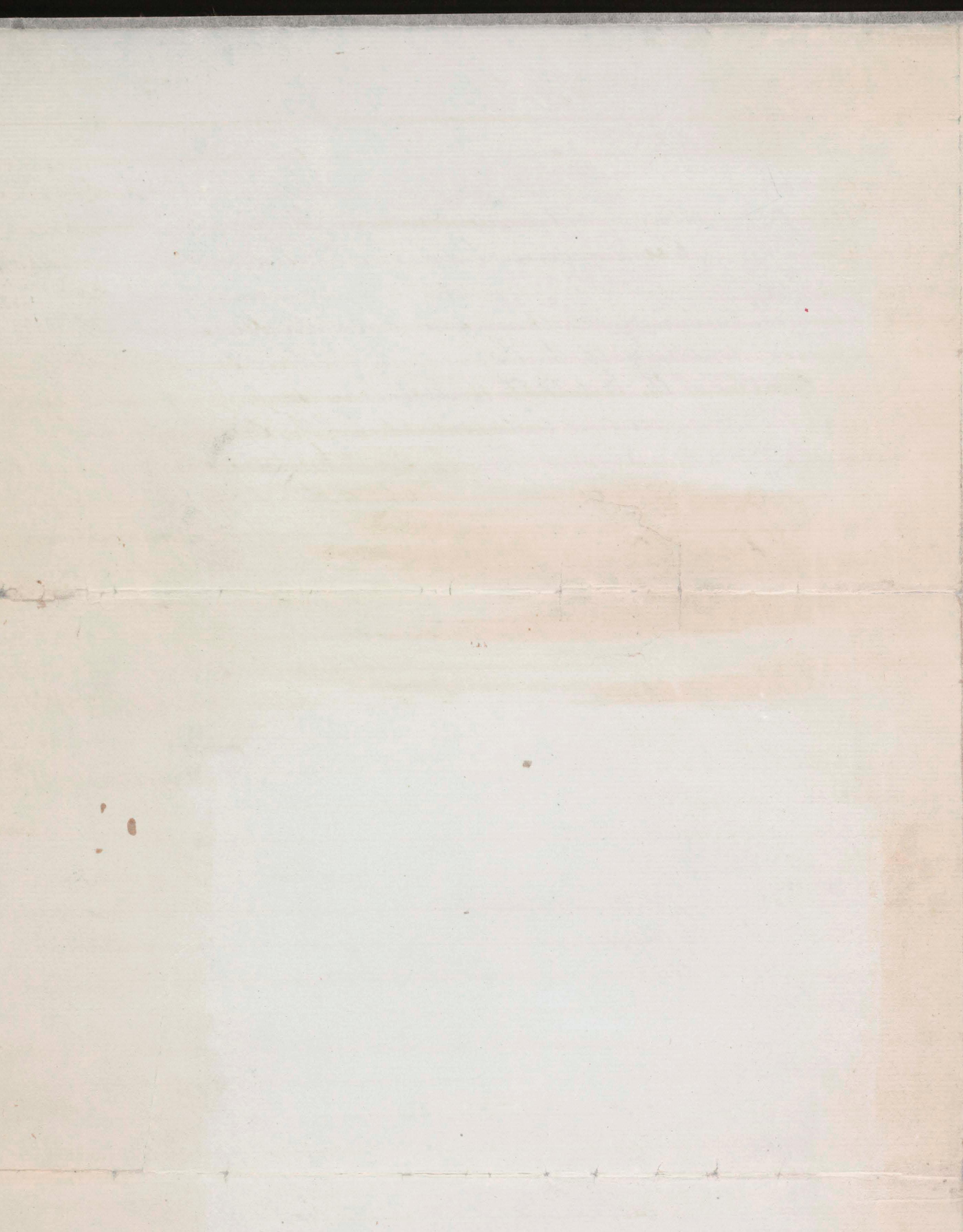
glossed over “colonial patterns of exclusion,” ignoring the Indigenous peoples’ experiences of land dispossession, loss of self-governance, and power inequality (Bryan, 2009, p. 25). Since the 1970s Indigenous communities have participated in mapping their own territories as a counter to the official state maps of exclusion and as a basis for reclaiming land, natural resources, and political rights. Interest in decolonizing education and museum exhibitions has contributed to the interest in developing maps that more accurately represent Indigenous communities— maps that reflect their sense of identity and connection to their land, and that incorporate traditional means of communicating and knowledge sharing (Bryan, 2009). The current state of interactive mapping technology and the experiences of Indigenous communities and museums in using this technology can be explored.
Many existing and historical maps, especially within museum and exhibit designs, have distorted Indigenous peoples’ histories and cultural knowledge. The historical misrepresentations of Indigenous peoples in our
educational and museum settings have portrayed Indigenous peoples as static peoples within their specific geographical territories and times. It is the nature of a static map that symbols are needed to represent people, places, and things, so whole groups of people are reduced to an image that is always going to be an oversimplification or generalization. They also do not account for the displacement of some Indigenous groups who fled from the genocidal injustices of colonialism, often resulting in groups taking refuge in new geographic
regions. For example, the Potawatomi, who at first contact lived primarily in southern Michigan, eventually relocated to various regions in North American including Manitoulin Island and Oklahoma (Borrows, 1994).
Maps and cartography have historically contributed to the advancement of colonization due to the dynamic and complex changing patterns of settler colonialism itself. European settlers needed to explore and map new landscapes and terrains to further expand and continue their European lifestyle. These first European maps of the Americas were originally based on Indigenous knowledge itself. Later, Lewis and Clark used the navigation techniques and guidance from Indigenous peoples to map the landscape of the Louisiana purchase (Bryan, 2011). Maps are intrinsically linked to the colonial agenda because they enabled the settler colonial agenda of conquest and control from afar. Captain Cook’s scientific knowledge of the geography of the Pacific Ocean was based on the oceanic knowledge of the Polynesian peoples. Colonial maps do not display the rich
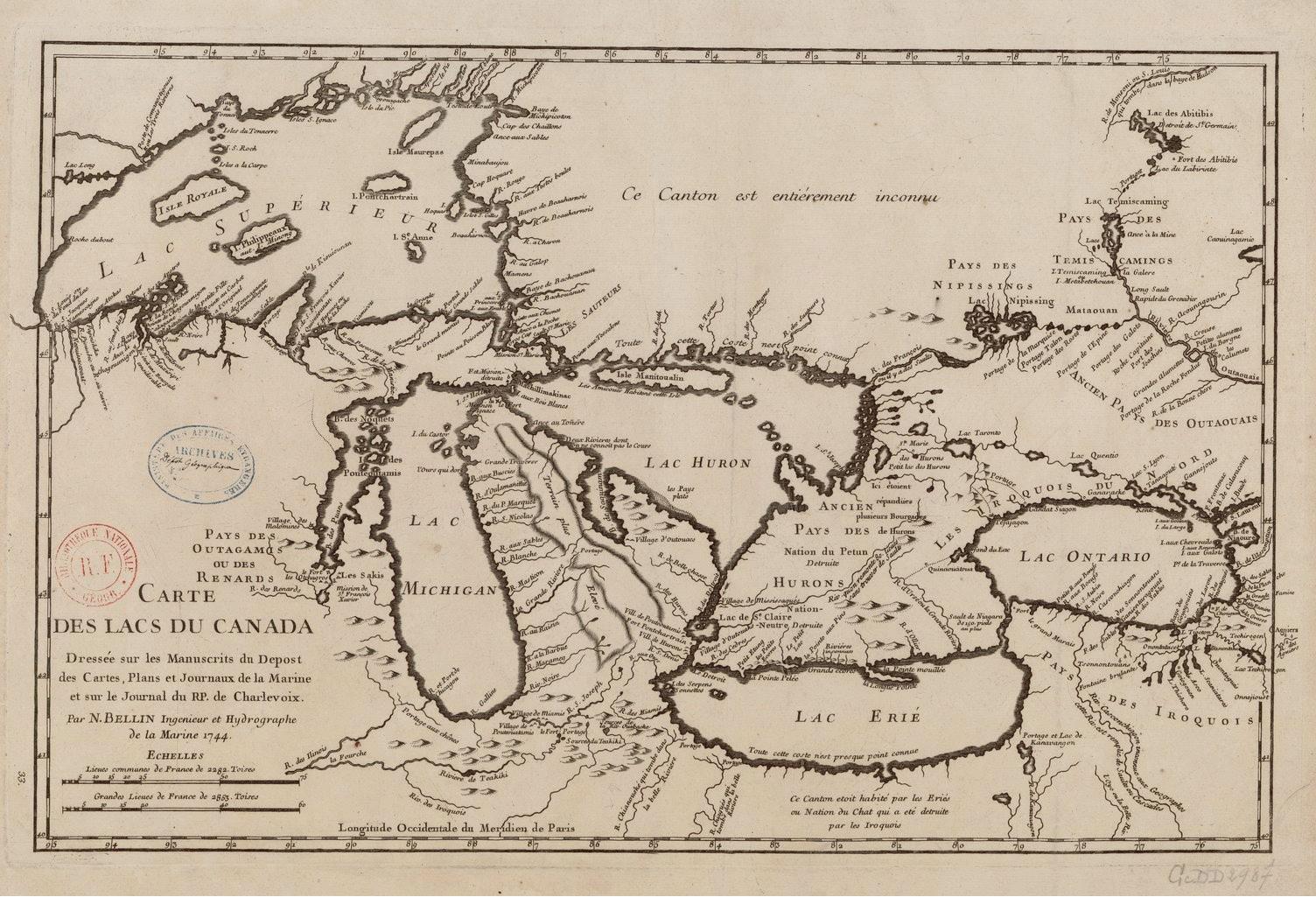
MANY EXISTING AND HISTORICAL MAPS, ESPECIALLY WITHIN MUSEUM AND EXHIBIT DESIGNS, HAVE DISTORTED INDIGENOUS PEOPLES’ HISTORIES AND CULTURAL KNOWLEDGE.Source gallica.brf.fr / Bibliothèque nationale de France
perspectives, stories, and connections that Indigenous peoples have to the land and to their specific regions. Place names are often not those used by the Indigenous peoples themselves, because most of the geographical names in North America were changed to either French or English following the arrival of Europeans. As we can see from the following map, the French mapped out the area of the Great Lakes in 1744. This cartographic information was based on the knowledge of Indigenous peoples themselves, which was embedded in their oral memory and language describing land formations and regions of inhabitation within the landscape (Borrows, 1994; Bryan, 2009).
Cartography produced through an Indigenous lens can help to reconsider concepts of indigeneity and resistance and proceed towards a more critically informed cartographic practice to regain territory and space and self-identity. One important issue about utilizing spatial history theory to reimagine mapping visualizations and the relationships between history and space over time is that it allows us to critically examine ways that stories have been interpreted
through the use of maps. When we use critical cartography to reinterpret history, it opens up new ways of conducting research (Bryan, 2009; White, 2010; Roth, 2013); namely, it allows conduct of research through a critical lens. Interactive mapping from an Indigenous perspective can also help in understanding the political and governmental systems of Indigenous peoples prior to European contact. Documenting their oral stories using a theory of spatial history can help visualize how Indigenous government systems can have multiple understandings within the same geographic space. It can also visualize how Indigenous peoples have adapted to the constant change within a dynamic Eurocentric political system that was foreign to them. Indigenous peoples have retained most of their cultural traditions despite the historical circumstances of settler colonialism. Producing a decolonized interactive map can also expose the contest between the power relations of knowledge and history between Eurocentric and Indigenous knowledge within a specific spatial area over a period of time.
Interactive maps using methods of spatial history and cartography can show change over time through oral history and relationship to land. Maps can portray the displacement of certain people’s histories and how their specific cultures became embodied within a specific place. Place is connected to the sociological conditions of human culture itself. To become encultured is to become intensively embodied within a specific place over time through inhabitation. History is a map of the past through certain stories and representations within a specific cartographic space. History can be researched through cartography, and historical representations can be interpreted and debated within the paradigm of spacetime (Ethington, 2007).
Historical geography is currently being used by geographic information systems (GIS) researchers working with historical data. Although historical GIS is an emerging field, it is still a broad genre that includes basic cartography and data research techniques within spatial historical theory. By critiquing Eurocentric versions of history and taking the narratives of Indigenous peoples into perspective, some of these historical sources can be used to change the narrative of the dominant version of history. Maps can be organized by existing categories and concepts of community knowledge and constructed to meet the needs of Indigenous governance systems. Some Indigenous

scholars and researchers are using new forms of digital technology to document and preserve the traditional narratives of their communities. Interactive maps can give credibility and impact to Indigenous narratives by documenting the history and knowledge systems of a specific area prior to colonization. Performances
or process” (Roth, p. 67), interactive maps appear to be useful in assisting Indigenous people with land and resource claims and in correcting misrepresentations of histories and cultures. However, it may be that it will first be necessary, as several Indigenous scholars have pointed out, for Indigenous scholars and researchers to take a more critical view of map making: first, questioning why maps should be made; second, what problems can and cannot be addressed by making maps; and third, understanding map making as a political process in which ideas and political objectives will be represented (Bryan, 2009).
of stories, songs, and dance and artistic visuals such as pictographs can all be documented through interactive maps.
Among the limitations that may arise from developing critical cartography from an Indigenous perspective is that cartography itself originated from Western knowledge systems. When Indigenous peoples start producing new mapping techniques through an Indigenous paradigm, they may have concerns about “the relationship between mapping Indigenous lands and reconfiguring power relations” (Bryan, 2009, p. 29). This could thus be considered a type of hybridity of knowledge through critical cartography when mapping is being situated within Indigenous knowledge systems. Although Indigenous mapping can be a tool of empowerment for Indigenous peoples to take political action by remapping and reclaiming their territory, it can also be embracing a liberal or neoliberal model of government that is based on property rights and land ownership (Bryan, 2011). Because they support the visual thinking that “reveals anomalies, patterns, and trends in the dataset that were previously unknown, leading to the generation of geographic insights or any new understanding (hypotheses, ideas, explanations, conclusions, etc.) about the true nature of the studied geographic phenomenon
Indigenous mapping based on Indigenous worldviews allows for a different perspective on the early history of North America. For example, at the center of Indigenous knowledge is the spiritual significance of visioning through the landscape. This is the foundation of land-based education. When we say that our stories are “within the land,” we consequently want to develop ways of mapping that can provide not only a physical visual representation, but a cognitive representation as well. In each place where Indigenous peoples stopped to live during their migrations, stories were created that were connected to that land and place. As time passed, the Indigenous peoples expanded their environmental and spiritual knowledge of that specific place. This knowledge was carried and passed on through stories of the specific landscape. It is like a visual or cognitive map of the landscape which gives them knowledge for their ecological awareness of the landscape. This type of knowledge can now be passed on digitally through the use of story maps.
When Indigenous communities and organizations initiate their own historical research, digital mapping techniques provide another way to move towards political sovereignty and cultural revitalization. This type of research and historical geography allows unique stories to be told, ones that are seldom told and taught within the classroom or in museum settings. Critical cartography that incorporates an Indigenous perspective in mapping can correct the dominant Eurocentric story that is usually taught within our educational settings and thereby provide students and citizens with a more accurate picture of Canada’s settler/ Indigenous history.
See the full 18th Century Map of North America on the next page.
WHEN INDIGENOUS COMMUNITIES AND ORGANIZATIONS INITIATE THEIR OWN HISTORICAL RESEARCH, DIGITAL MAPPING TECHNIQUES PROVIDE ANOTHER WAY TO MOVE TOWARDS POLITICAL SOVEREIGNTY AND CULTURAL REVITALIZATION.



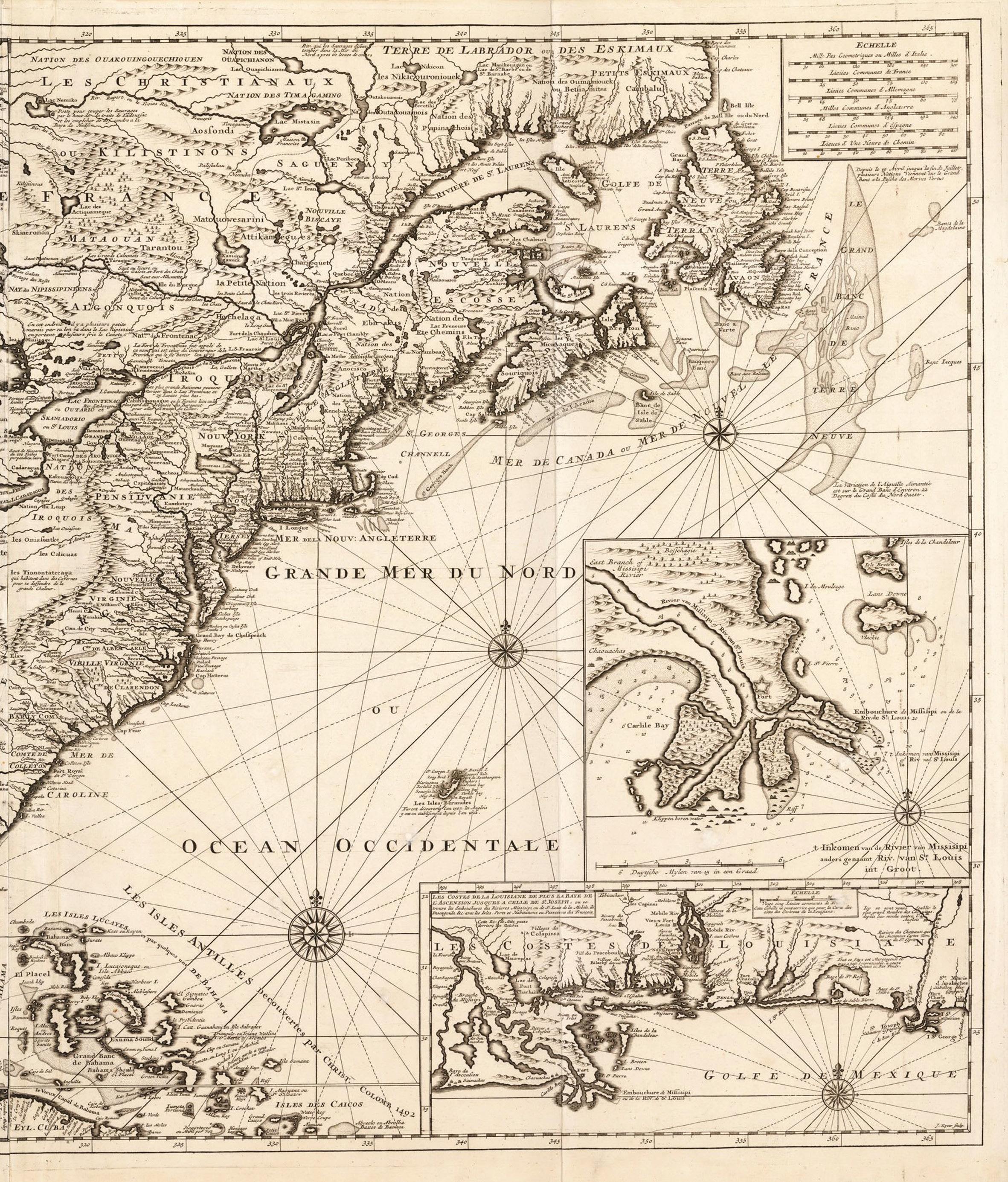
The White Ribbon Campaign stems from a Shake Tent Ceremony. The Traditional Ecological Knowledge (TEK) Elders were advised to put white ribbons on trees in the Robinson Huron Treaty (RHT) Territory to stop the use of glyphosate in the RHT territory. The TEK Elders need your support in putting the white ribbons on trees. Supporting the White Ribbon Campaign will ensure future generations can continue to live the Anishinabek way of life.

The TEK Elders are a group of Elders from the RHT Territory led by Raymond Owl of Sagamok Anishnawbek. The Elders came together with the purpose of stopping the use of glyphosate in our territory.

The TEK Elders hold expert Indigenous scientific knowledge of our traditional territories. Our knowledge systems tell us everything is connected; that we are related to the animals, the birds, the plants, to all life. We are kin and need to acknowledge that we depend on other beings for a healthy life. The TEK Elders know that glyphosate is poisoning our land.
In forestry operations, glyphosate is used to kill plants that compete with certain trees, such as jack pine (pinus
banksiana). It’s sprayed typically by air over recent clear cuts or select cuts to kill competing plants such as birch and maple trees.
Glyphosate is a herbicide. It’s the main active ingredient in weed control products like Roundup—it’s used to kill plants. It is one of the most widely used herbicides on lawns, in gardens and forestry operations.
Glyphosate is killing more than just plants. The TEK Elders say it is killing the birds, the animals and poisoning the waters. Very few studies have been done to determine how glyphosate affects birds, animals, and waters. If the studies are done, the effects are poorly understood. Also lacking are studies on how glyphosate affects Indigenous ways of

knowing and being. The old people say, “If we poison the lands, we are poisoning ourselves.”
When glyphosate is sprayed, it can be picked up by the wind and moved to other places; it can land in the waters.
The TEK Elders know that we are dependent on the health of the Earth. In many areas of the RHT territory, we cannot trust that the medicines and foods are not contaminated by glyphosate. Our way of life comes from the lands; if the lands are sick, we will be sick.

Glyphosate stays on the plants and in the root systems, which means anyone or anything eating the plants and roots may get sick.
Elder Ray has always advocated for the protection of the lands, the air, the water, the wildlife, and medicines. He is guided by the ancestors and remains as resilient as in his days of youth. Elder Ray had a vision where an old person came to see him, speaking the old Anishinaabe language. This vision is what drives Elder Ray to stop the spraying and destruction of our territory.
Elder Ray Owl’s message is “Boontun,” which means stop it. It means to stop it in a demanding way. Stop the use of glyphosate in our territory.
The TEK Elders have hosted demonstrations, met with government officials, and met with industry but they don’t listen. It is time to listen to the TEK Elders and stop the poisoning of our lands. The aerial spraying of glyphosate violates our Treaty rights to the waters and to hunt, fish, and gather berries and plant medicines in our territory.
Please support the TEK Elders and help stop the destruction of our territory by tying white ribbons on trees. Miigwech.

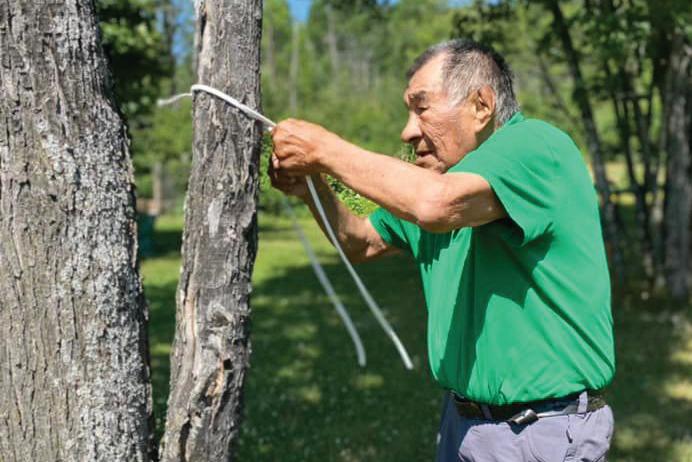

ELDER RAY OWL’S MESSAGE IS “BOONTUN,” WHICH MEANS STOP IT. IT MEANS TO STOP IT IN A DEMANDING WAY. STOP THE USE OF GLYPHOSATE IN OUR TERRITORY.
The Robinson Huron Waawiindamaagewin (RHW) team invited Edna Manitowabi to spend some time with us and share her knowledge and perspective on the Creation Story. The following is an excerpt of the story she shared with us.

I wanted to share with you about the Creation Story. How I came to hear it and the effect that it had on me. They tell us that in the Creation Story, everything is in there, the tools that we need in life are all there. It’s the same as the first sound you hear, the sound of the shishigwone, the way it sounds, that what was out there, in the darkness the emptiness, that void, the sound of the gourd shaking. People have asked if the Creator is male or female. Is God male or female? For me, I have an image of a dark place where the sound goes out forever into the vastness of the emptiness. When I hear that, that’s what I see.
Then, they talk about thought. The first thought and then the moment and thought two goes out, we send our thoughts and they go out into creation, to the universe, everywhere our thoughts go out. Thought is medicine. That’s my understanding, what we think is medicine. The fact the Creator sent out those thoughts into the vastness, into the darkness, but he wanted a place where those thoughts, so there was a circle that was created, with his thoughts created a circle.
It’s still dark and so again his thoughts he wanted to have light and so he made light, the fire there was a fire, and with
that fire, there was a duality that was created. We see that, we see that duality when he created fire. It was the sun, the partner to the sun is the moon. So there again in our teachings and that creation story, there is a duality, there is male and female. Wherever we look, there are male and female energies all over creation. The duality is light and dark, male and female.
Then, of course, there has to be movement, we do have to have movement. We went around in the four directions, and in that same way, the Creator caused everything to move. To move in that circle he had created that, a beautiful beautiful place, a very very beautiful beautiful place. With movement came the winds, the breath, the air that we breathe. We depend on the air, we depend on the wind. We rely on that to give us life but we also depend on our mother, the earth.
And so with that was created a most beautiful beautiful beautiful woman. Woman was created. When the Creator looked out upon the land, this most beautiful beautiful woman he sent. She sent the birds, the birds of many different colours of many different sounds of many different shapes to go out all over creation and spread
EDNA MANITOWABI, ANISHINAABE KWE, IS BEAR CLAN, A GRANDMOTHER, AND GREATGRANDMOTHER, OF OJIBWA/ ODAWA ANCESTRY ORIGINALLY FROM WIIKWEMKOONG, MANITOULIN ISLAND.

their seeds and so sprang up that incredible beautiful beautiful life that we see out there, everything in creation, a most beautiful woman the first woman, our mother the earth and even those medicines that are out there everything in creation there’s a song the birds sang those songs so all the medicines that are out there, that’s that’s the blessing.
Finally, last but not least, Anishinaabe right. Anishinaabe the last one to be created, the last one, everything is already in place. Everything, the whole of creation and so parts of the earth were taken, the above, the below, they were molded and shaped, a being will be. The Creator, took a sacred shell, took a small shell and breathed life into Anishinaabe. Breath. Sacred breath, first one is that spirit. Second breath is changed life. The spirit is eternal, that’s a blessing, everlasting life, eternal life, and changed life. You don’t stay the same, there’s evolution. You evolve, you grow, you change. And so, touched him on the chest to set the heart (ode), to beat in rhythm and in harmony with the rest of creation. Not only the sky world, but all of creation, in harmony rhythm and so there is that balance. After the thoughts, the heart, the spirit, all of that, he is ready and ready to be and he was encouraged. Anishinaabe was encouraged go and live life, now go and
you put your feet on the earth and live life to the fullest, be creative in the way that you do things, do it with your heart, do it with your thoughts, good mind, good heart and that’s how he was being.
Anishinaabe knew that he came from love because of the way he had been moulded, zaagidewin, he was created with love compassion, with the most gentleness. He didn’t want to leave the Creator’s side, he didn’t want to leave, he hesitated doesn’t mean we’re slow he hesitated he took his time. As he began to leave the way he had been created, and as he was being lowered coming down from that spiritual realm, through those levels in the sky
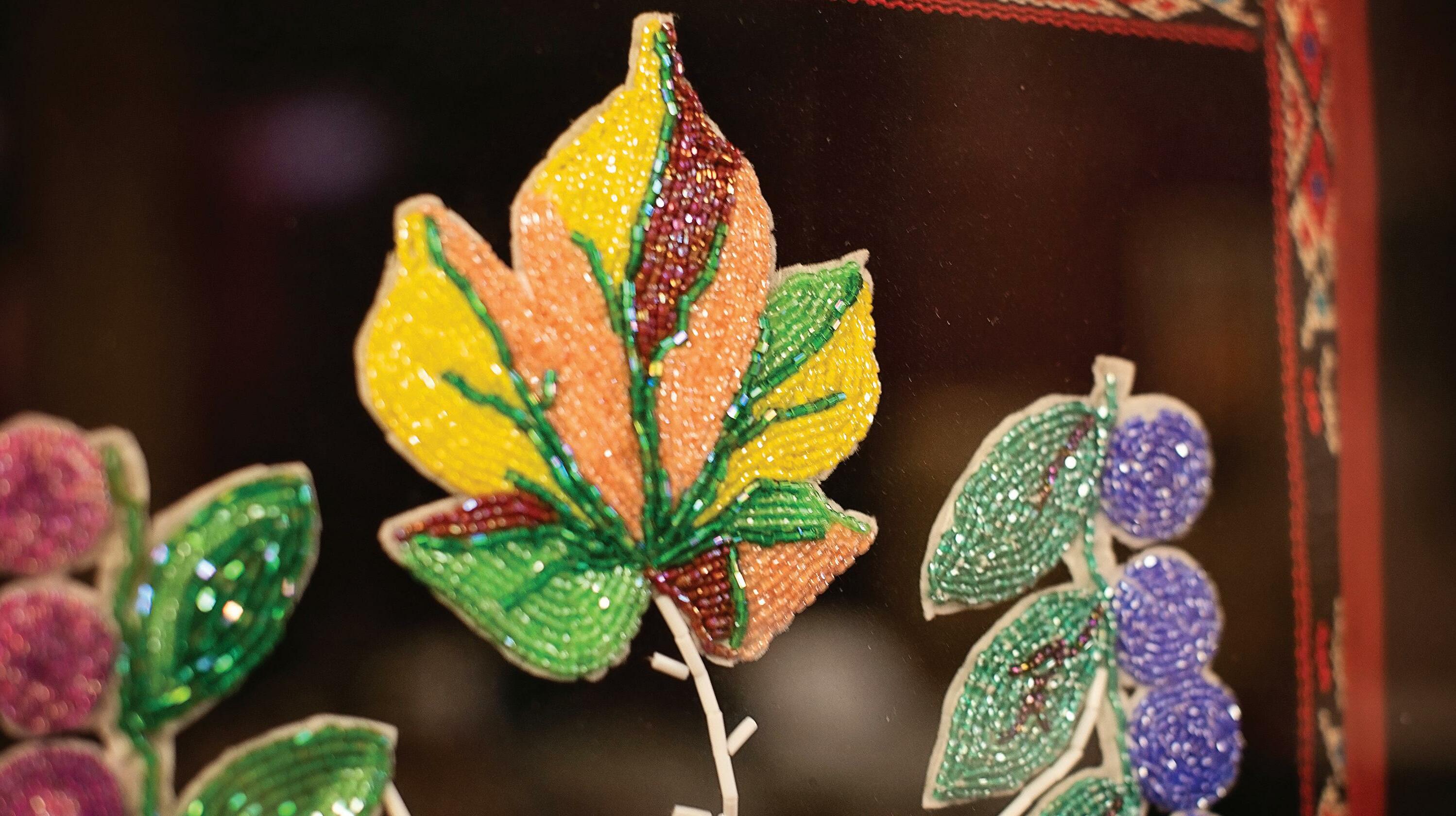
SACRED BREATH, FIRST ONE IS THAT SPIRIT. SECOND BREATH IS CHANGED LIFE. THE SPIRIT IS ETERNAL, THAT’S A BLESSING, EVERLASTING LIFE, ETERNAL LIFE, AND CHANGED LIFE. YOU DON’T STAY THE SAME, THERE’S EVOLUTION.
world, he saw the magnificence. The incredible beauty of the earth and he was just in great awe, he was in awe of what he saw and so he this is where some of our dances come from. He stuck his toes out so he wouldn’t disturb not even a blade of grass. When I hear and see that image, I see humility. How the first man touched a woman, the earth, with great respect, great humility and honour. Anishinaabe knew, that she was already full, she was already whole and complete and he is the last one to be lowered. This woman is already whole and complete. What a blessing he saw. That Anishinaabe saw that, so he might celebrate life and he went out all over creation.
So I just wanted to share bungi (a little bit) about our Creation Story, sharing it the way I picked it up, the way I began to put it in my life. I inserted myself into that Creation Story. From the first thought and then the sound, the sound of the gourd what is the sound that I make? How do I make that sound, do I make that sound with kindness, with gentleness with compassion? What about my heart? What about the air that I breathe? We all depend on air to breathe for life. Everything in there, in that creation story, the duality, the balance, your

mind, your heart, your attitude, what we do, how we move, how we walk, how the wind makes us move, we all move in a creative sacred manner because we are sacred beings. You are a spirit, you are a beautiful beautiful spirit. You’re a sacred human being and that is something that we’ve all always known, that was given to us in that creation story.
I’ve spent my adult life wondering about life and our purpose, our reason for being. why we’ve come into the world. We all do and we all need to work together. Men and women, the work that we do together to bring about balance in our communities, in our families. A woman was given the responsibility because, in that teaching, the Creator gave to a woman, now you are the Creator, you woman are the Creator, you bring forth life, you do what’s already been done. You have that blessing, to bring forth life. She’s the only doorway in which a spirit can come into the world. We give birth, we do in that creation story, what was done outside up there, what was done for Anishinaabe, we do that for our people.
This is an excerpt only. Listen to the entire Creation Story teachings at https://youtu.be/tNijFBU3bUc
 By Earl Commanda
By Earl Commanda
Mii maa weweni genji naanaagidowendamiing g’da-nweninaan. For two weeks in August 2022, it was time to focus on the language together in total immersion during the Anishinaabemowin Language Camp at Anderson Lake Spiritual Centre. As a first-time immersion student, I certainly had a difficult time being totally immersed in the language. My goal was to use the language tools effectively and begin to address simple conversation in Anishinaabemowin, beyond hello, my name, my clan and where I am from.
One of the most difficult transitions to conversational Anishinaabemowin is knowing the names of various objects or nouns and then knowing how to use proper verbs (actions) in the proper tenses (past, present, or future), and whether they were singular or plural. Some consideration must be given to whether the object is animate or inanimate when using the additional pre-verbs or adverbs to give the language more life and meaning.
The other major consideration is to understand when to use yourself (me), someone else (you), we (s/he) third person including yourself, and they (s/he) fourth person excluding yourself. Finally, to make it more conversational, speaking may start as a question that includes words of when, where, what and how which changes things by adding such words in front of or behind the verbs.
For example:
Jiibaakwe means She or he is cooking.
Jiibaakswe na? is S/he cooking?
A command to just cook is Jiibaakwen!
Inclusive of we, including yourself is Jiibaakwedaa –Let’s (all) cook.
To include just yourself (me), you would add to the front – Ndoo-jiibaakwe.
If more than two people are cooking, you would add to the end of – Jiibaakswewag – They are cooking.
So, you can see that the root verb ‘to cook’ changes with singular or plural context (me, you, they). To make this a fun exercise, each team of two to three students would prepare a short skit just before supper to describe the food they would eat that evening. Often the skit would end with Wiisinidaa – Let’s all eat.
Advanced Anishinaabemowin lessons focussed on the use of preverbs to supplement the conversation using the word, i.e. ‘epiichi’, which gives greater meaning to your talk. For example, N migwechwendam epiichi gmiwang –I am grateful that it’s raining.
So let me try to put this all together for you in what is known as a ‘magic’ formula for language learners to use as follows:
Gaawii(n) ngii-gchi-baapsiimi(n)
We didn’t laugh hard.
(Note: when negating the word, no/gaawiin must be said and the negative suffix sii must be added to the root verb.)
Me (or us excluding you when followed with mi(n))
giipast tense gchigreat, big, very baap(i) s/he laughs sii negative suffix mi(n) plural ending for us
Participating in an Anishinaabemowin Immersion Camp is highly recommended for all potential language learners. Use of the language is forced and challenges the limits of our ability to recall phrases, words, and context.

My goal now is to listen intently to language speakers, practice with co-learners often and use the resource tools such as dictionaries and various handbooks.
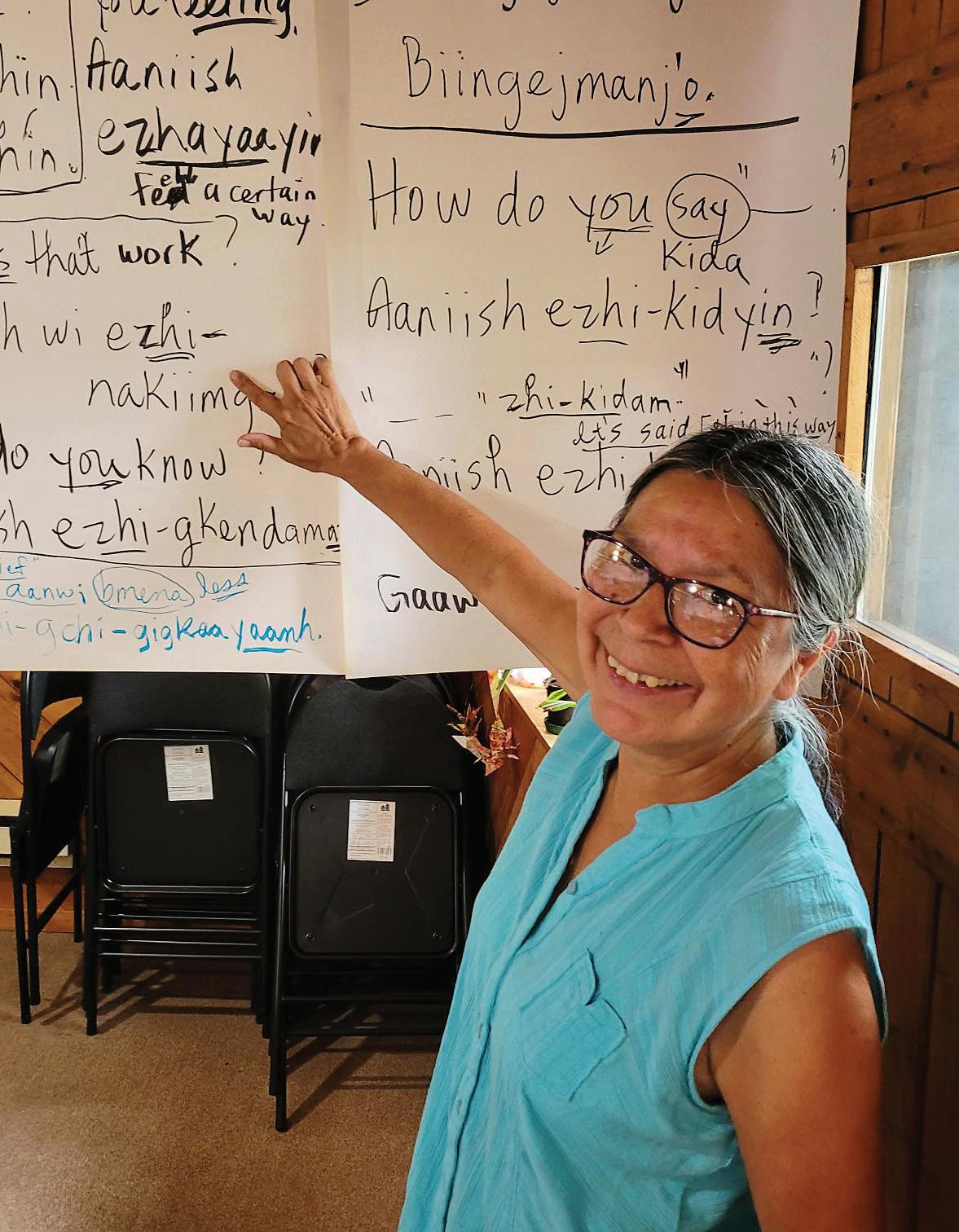
Hello Boozhoo/Aanii(n)
Bow-zhow / Awe-nee(n) Some communities say aniin and some say aanii.
__ is my name. __ ndizhnikaas. __ dizh-ni-koss. Could be used for any name.
__ is what I’m called. __ ndizhnikaanigoo. __ dizh-nih-kawn-goh. Could be used for nicknames or a name you prefer to be called.
__ is my English name. __ nda-zhaagnaashiinoozwin aawan.
__ duh-zhawg-nawsh-ee nose-win awe-wun.
__ (is) my Anishinaabe name. __ nda-nishnaabe-noozwin (aawan). __ duh-nishnaabe nose-win (awe-wun).
__ is my clan. __ ndoodem. __ dough-dem
I don’t know my clan yet. Gaawii mshi ngikenmaasii ndoodem. Guym shi geek-en-maw-see dough-dem.
I am from __. __ ndoonjibaa __ doughn-jih-baw
I am a band member of __. __ ndoo-dbendaagwos __ dough-dih-ben-dogwuss. Literally means ‘I belong there’.
I live in __ currently. __ megwaa ndi-daa. __ megg-waugh dih-daw. If you live somewhere different than where you are from/grew up.
I am a __. __ ndaaw. __ dow. Can be anything: Anishinaabe, Zhaagnaash, Wemtigoozhii, job title, etc.

I work at/in __. __ ndoonji-nakii. Endaayaanh ndoonji-nakii. __ doughn-jih nuh-kee. Could be used for an organization you work for or a location of work (as most of us work remotely and in different areas of the North Shore).
Things are okay. Mii go aanwi. Mee goh awn-wih
I am happy (to be here). Ngichinendam (mampii wii-yaayaanh).
I am thrilled. Nmaamiikwendam (mampii wii-yaayaanh).
Gih-chi-nen-dum (mum-pee wee-yaw-awe).
Nih-mommy-kwen-dum (mum-pee wee-yaw-awe).
I am tired. Ndeyekos. Day-uh-kwoss.
I am busy. Ndoond-mitaa. Doughnd-mih-taw.
I am thankful. Nmiigwechwendam (mampii wii-yaayaanh).
Nih-mee-gwetch-wen-dum (mum-pee wee-yaw-awe).
And you? Kiin dash? Keen dush?
That’s it. Mii sa wi / Mii sa iw. Mee suh wih / Mee suh ew.
Clap Hands Paskaninjiin (Pusk-uh-nin-jeen)
Thumbs Up Ngichi-nendaan (Gichi-nen-dawn)
Love Nzaagtoon (Zawg-tone)
Yes/Agree Enh
Raise Hand Mbinkenin (Bin-kay-nin)
No/Disagree Kaa
Go Back Nengaach (Nang-gawtch)
Joy Ngichi-baashkaap (Gichi-bawsh-kawp)
Go Faster Wewiip (Weh-weep)
Surprised Nmaamkaadendam (Ni-mawm-kaw-den-dum)
Tada Minwaangozwin (Min-waun-goze-win)
Lower Hand Niisnikenin (Niece-ni-kay-nin)
Camera Off Aatebidoon gmaznaazgan/ gmaznaakzigan (Aw-tay-bi-dune)
Camera On Aaskanebidoon gmaznaazgan/ gmaznaakzigan (Aws-kun-eh-bi-dune)
Click it Maagbidoon (Mawg-bi-dune)

Arriving Bi-dgoshin Bih-dig-oh-shin
Asking Kwedwe Kwed-weh
Awake/Waking up Gshkozi Shkoh-zih
Cleaning Biinchige Bean-chi-gay
Cooking Jiibaakwe Jee-baw-kway
Doing something Zhichige or Nan’kii Zhi-chi-gay or Nun-kee
Driving to Sudbury Piza Sudbury Piz-uh Sudbury (not pizza!)
Eating Wiisni Wees-nih
Finishing Giizhiitaa Gee-zhee-taw
Get/be dressed Biiskonye Bees-kun-yay
Get/be undressed Giiskonye Gees-kun-yay
Going Zhaa Zhaw
Going for a walk Bbaamse Palm-say
Going Home Ni-giiwe Gee-way or Gee-yay
Hearing Noondam Known-dum
Leaving Ni-maajaa Nih-maw-jaw
Listening Bzindam Bzz-in-dum
Reading/Counting Gindaaso Gin-daw-soh
Saying hi Aanii kido Awe-nee kid-oh or Awe-nee kid-uh
Showering/Bathing Gziibiigzhe Gi-zee-beeg-zhay
Sitting Nimadabi Ni-mud-uh-bi or Mud-uh-bi
Sleeping Nbaa Baw
Speaking English Zhaagnaashiimo Zhawg-nawsh-ee-muh
Speaking the language Anishinaabemo A-nish-naw-bay-muh
Standing Naaniibwi Naa-nee-bwih
Starting Maajtaa Mawj-taw
Taking a break Ke-boontaa Keh-bone-taw
Telling Wiindmaage Weend-maw-gay
Understanding Nsastam Sus-tum
Watching TV Mzinaatesjige Mzin-aw-tess-ji-gay
Washing Hands Gziinjii Gzeen-jee
Working Nokii Nuh-kee
Writing Zhibiige Zhi-bee-gay

Keep in mind that although the translation is written in short form as ‘arriving’. For example, that it actually means ‘She or he is arriving’, ‘She or he is asking’, etc. They are full sentences.
All of these words are verbs (action words), called verb animate intransitives (VAIs).
To study these on Quizlet online: https://quizlet.com/ ca/588124456/everyday-actions-flash-cards/
Answer key:
 By Cheryl Recollet
By Cheryl Recollet
In the spirit of honouring our leaders, we want to acknowledge our wise ones, the ones who share time and guide us in the work we are doing. We recognize our Elders who are supporting us and encouraging us to do the right thing. One of those Anishinaabe kwe (women) Elders we often see is Waubenopitchikwe, aka Lila.
Elder Lila Tabobondung Waubenopitchikwe comes from Wasauksing and is always showing her support for our Treaty. She has attended several of our Treaty events and has been present during many of the court proceedings when location has been accessible. She also contributed to our Daagwaagin 2021 Robinson Huron Treaty Times Magazine sharing with us her beautiful poem, On the Wings of an Eagle Soaring.
Elder Waubenopitchikwe reached out to Robinson Huron Waawiindamaagewin to discuss an appropriate land acknowledgement for the students and school of Rosseau Lake College (RLC). Elder Waubenopitchikwe works very closely with RLC to ensure Anishinaabe teachings for their students.
Elder Waubenopitchikwe is a residential school survivor and has been recognized by her community. RLC students have also acknowledged Elder Lila’s contributions:
“Gchi-miigwech to Elder LilaTabobondung for supporting the RLC community in growing our understanding of the residential school system and its impacts, both past and present.”
We are so happy to showcase Elder Lila Tabobundung Waubenopitchikwe and her contributions to our Treaty and youth initiatives. Gchi-miigwech Elder Waubenopitchikwe, aka Lila.

All children and youth are knowledge and truth carriers for the next 7 generations.
Anishinaabe children and youth will see, know, and understand who they are, and their spiritual connection to the land and all that is.

They are the ones who will think from the heart and learn about Treaty rights and their responsibilities to the land and people.
Indigenous and non-Indigenous children and youth will share their knowledge amongst themselves, and together they will work to protect the land and life for future generations.
We are all children of the land.
We are the children of the land
Our way of life is in our hands
We are the children of the land
We need our language to understand
We are the children of the land
Give us your love and hold our hand
We are the children of the land
Protect our life, protect the land
Song received by Waubenopitchikwe, August 2003
Yin’s Legacies’ beautiful applique hoodies with Indigenous women cut-outs caught Cheryl Recollet’s eye. She had to order a custom hoodie right away featuring a blonde Anishinaabe kwe.


Cheryl found Yin’s Legacies on Facebook and reached out right away. She loves the beautiful, body-positive Indigenous silhouettes. They speak to our pride and love for all creation. To Cheryl’s surprise, the shop is located right here in Robinson Huron Treaty Lands.

Yin’s Legacies is co-owned by sisters Jasmine and Amanda and is named after their late father, Yin Eugene Allan Syrette. Created to always carry on the legacy of their father, the
creativity and thoughtfulness featured in every piece are grounded in Yin’s example of kindness and love.

Jasmine’s artwork has been sold at powwows across Turtle Island and more recently entered the international market. Taking inspiration from Ocean Kiana’s work on body positivity, Jasmine’s latest series features hoodies designed with beautiful bodies of all sizes, custom applique and traditional ribbon work.
Yin’s Legacies makes just about everything including regalia, beadwork, ribbon skirts and applique hoodies. Check out Yin’s Legacies in our Holiday Gift Guide on page 81. Follow Yin’s Legacies on Facebook and on Instagram (@yinslegacies).

Tracy Toulouse is our Anishinaabe fashionista extraordinaire! You often find Tracy and her fashions at powwows and gatherings across our Treaty Territory.
She and her Swirling Wind Designs have long been favourites of Robinson Huron Anishinaabe. We all love and have adorned her hip shaker purses and fringe bags. More recently, Tracy has been gaining international exposure, including a feature at Paris City Fashion Week.



Tracy debuted her model daughter, Scarlett Roy, at Paris Fashion Week. Scarlett’s intriguing mysterious look combined with Tracy’s innovative designs proved to be a powerful duo. It was an exciting day in fashion for Anishinaabe. Across Turtle Island, Anishinaabe were eagerly watching and following Tracy achieve her dream and that day, it felt like we all achieved our dreams.
Tracy is Bear Clan and from Sagamok Anishnawbek in Robinson Huron Treaty Territory. We are very proud and honoured to showcase Tracy in this edition of our E-Wiindamaagejig: The Robinson Huron Treaty Times.
Tracy’s inspiration to design clothing came from her grandmother, who is a respected and talented quiltmaker. As a kwesenhs (child), Tracy would sit by her grandmother’s side and watch her sew. Tracy followed her interests by taking clothing construction courses in high school, then continuing creative fashion design instruction in college. She also completed an internship with the prominent Linda Lundstrom Company as part of her graduation from a three-year business program.
This year has proved to be a remarkable one for Tracy! She was featured at Manito Ahbee Festival in Winnipeg, Manitoba, was nominated for an Ontario Arts Council Award, and attended the Gathering of Nations in Albuquerque, New Mexico.
Tracy’s next feature will be Milan Fashion Week— the fashion industry’s iconic event. She is making
preparations and hopes to bring a small group of women to the event to share experiential stories. Tracy always believes in helping each other and assisting women.
On the Beyond Buckskin page, Tracy stated, “Someone helped me see my spirit is in my clothes. When we create, we put our spirit in the outfit—share that spirit with other people—just as in traditional garments. All have spirit, and the art we create is symbolic and we carry the outfits in high regard. There is power in what we wear.”
Be sure to follow Tracy on social media and support Swirling Wind Designs. Chimiigwech Tracy for contributions to Anishinaabe grace!
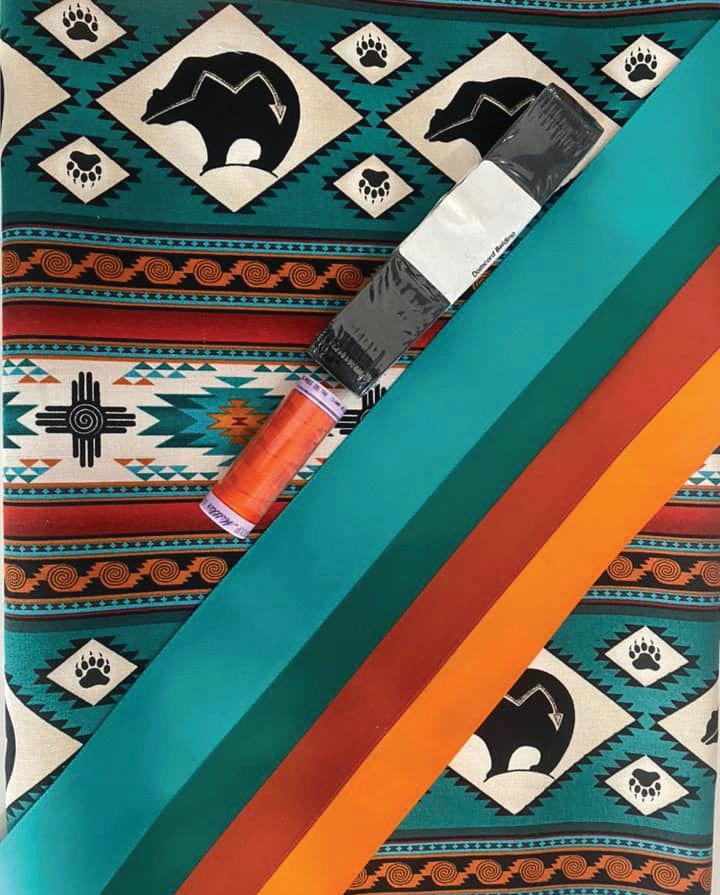
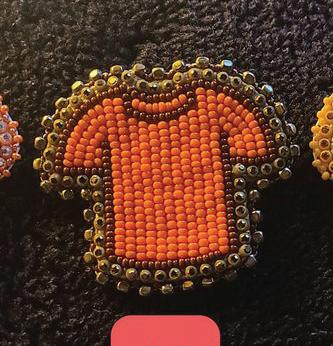
Trailblazing Beads is the only store in Baawaating (Sault Ste. Marie) dedicated to offering Indigenous arts and crafts supplies along with genuine, Indigenousmade products at competitive pricing. They offer monthly and weekly sales and have a wide selection of beads, pony beads, needles, thread, and hair pipe bone beads, and also take special orders for beadwork.



Trailblazing Beads was founded by Eva Daybutch and was inspired by her mother who owned a business called Trailblazing Women with four other friends from Mississauga First Nation. As a young girl, Eva would travel with them around the North Shore helping at powwows and festivals selling arts, crafts, and beadwork for regalia. Eva has been immersed in her Indigenous culture from a young age and it has influenced her way of life today.
Through Trailblazing Beads, Eva is committed to encouraging people to participate in the Indigenous culture through arts and crafts and traditional beadwork. Arts and crafts can provide healing and wellness opportunities for those wishing to reconnect and decolonize themselves with Indigenous culture. Trailblazing Beads has entered the market as a business with a social mission to empower and encourage participation in traditional Indigenous culture through beading, arts, and crafts.
Follow Trailblazing Beads: facebook.com/trailblazing.beads
Stephane Pangowish has been taking Anishinaabe comedy by storm! She has been featured in many Robinson Huron communities and has even been MC at many of our powwows this summer. If you have not had the chance to check out Stephanie, we encourage you to do so.

Stephanie is a “sassy, bad assy,
class Anishinaabe-kwe from
on Manitoulin Island,” as stated in her online biography.
Stephanie’s comedy really took off during the COVID-19 pandemic when she began to do many online comedy shows and workshops. She was featured in GOTLAND with many other Indigenous comedians. Her GOTLAND biography describes Pongowish as “(...) one of the deadliest Indigenous Aunties you’ll ever meet. Originally from Wiikwemkoong (Wee-kwem-kung) Unceded Territory on Manitoulin Island, Pangowish now stalks the streets of Toronto, terrorizing the local prudes. Her sexuallyloaded (and educational, we swear!) comedy will arouse your mind with insatiable thoughts of copulation and decolonization.”
Stephanie is from Sagamok Anishinawbek and Wiikwemkoong. She has a background in Indigenous Studies from Trent University, stating that she “barely passed, NDNs studying NDNs.” She continues to learn from her children, family and community. Stephanie is an active community member, stand-up comedian, Northern Style Women’s Traditional dancer, educator, backup singer, and an avid beader. Stephanie has fostered her comedic career by developing shows, and workshops and providing Master of Ceremonies (MC) services.
In her Indigenous Comedy Workshops, Stephanie leads groups into laughter through Indigenous-themed improv and comedy exercises. Many of her participants felt a new confidence in their public speaking and were excited to show their friends their new skills. One participant even reported feeling “fresh, like a new pair of underwear.”
You might have spotted Stephanie on the powwow trail this summer. Stephanie was invited to MC powwows across our Treaty Territory, including Atikameksheng and Wiikwemkoong, amongst others.
Stephanie’s MC experience incorporates “some freakishly, amazing Indigenous humour, and her perspective on Indigenous business, life, powwows and everything in between. She engages her audience with some Indigenous knowledge—creating a room full of laughter, even on the driest of subjects.”
Stephanie is one to be seen this year. Be sure to follow her on social media and check out her website for a show coming near you.
www.stephaniepangowish.com

Breeze Ozawamick started her first business at the tender age of ten years old—Breeze’s Desserts. Breeze comes from Wiikwemkoong and is no stranger to the food industry. Breeze has been working with her mother, acclaimed Red Seal Chef Hiawatha Osawamick, since she was a toddler.

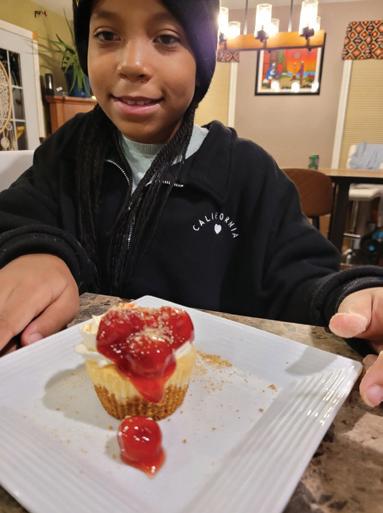

Breeze has always felt very comfortable in the kitchen and has accompanied Hiawatha on many catering trips as well as watched her mother launch her restaurant business. In the summer of 2021, Breeze was able to lend a helping hand at Hiawatha’s Food Truck in sunny Wiikwemkoong.


In the spring of 2022, Breeze decided to open up her dessert business and began by designing her logo on her iPad. Breeze’s Desserts began offering products at her mother’s food truck starting with her specialty—the Marshmallow Chocolate Chipwich, a marshmallow filling sandwiched between two homemade chocolate chip cookies.



Breeze said she started her own business because she likes sweets too much and wanted to make money too. Her mom Hiawatha says, “Breeze has a sweet tooth like her Grandpa and I hope that she will open up a savings account.”
You can find Breeze this summer and fall offering her tasty treats at Hiawatha’s Food Truck in Wiikwemikoong. Breeze is currently available for orders and customs.
Gchi-miigwech Breeze for your amazing desserts—keep up the hard work!
Ogimaa Bob Chiblow of Mississauga First Nation with his wife Ronda Peltier has been operating Chiblow Fish for many years. Many Anishinaabe across Robinson Huron Treaty Territory have enjoyed the delicious giigonh fried up by Ogimaa and Ogimaakwe. You can find Chiblow Fish at many community gatherings, powwows and catering events.
The Mississauga First Nation elected Ogimaa Bob Chiblow on October 21, 2021. As a new Ogimaa, he has still been actively working on his business with his wife Ronda.
Recently, Chiblow Fish launched an exciting new product—Chiblow Fish Coating, with which their signature fish batter is made, something that has made Chiblow Fish famous!
Chiblow Fish is available for a wide variety of community events and catering. They offer many products. including local walleye tenders, domestic walleye burgers, Lake Erie pickerel fillets, and European pickerel cheeks, as well as their famous batter!

Be sure to check out Chiblow Fish at your next community gathering or on the Anishinaabe powwow trail. Miigwech Bob and Ronda for your delicious giigoonh.

Originally from Manitoulin Island, Ontario, Creator’s Garden is now based out of Peterborough, Ontario.
Joe describes himself as a learner and an educator, and characterizes Creator’s Garden as “a 365-days-a-year outdoor-education based business dedicated to learning and teaching about the uses of hundreds of plants from Canada’s Great Lakes region.”


Joe shares knowledge of plant life and uses related to our Robinson Huron lands. He is well known across many online and in-person platforms. His online presence is focused on his Patreon account, and many of his clips can also be seen on YouTube and Facebook. Joe and Creator’s Garden have gained a meaningful reputation and following amongst many across Turtle Island and abroad.
Joe shares an abundance of knowledge related to health and healing with our plant relatives. Creator’s Garden has conducted extensive programming in over 100 Indigenous communities and over 150 different institutions throughout Canada and the United States and the focus is on optimizing human health using mainly medicinal plants but also through other traditional practices.
Anyone who has had the opportunity to interact with Joe, either online or in person, is immediately drawn to his passion for sharing and love for plants. He often will feature his daughter Ruthie and their dog, Rosie.
Creator’s Garden can be found on social media and on his Patreon account.
— CREATOR’S GARDEN
“WE ARE FOCUSED, FIRST AND FOREMOST, ON TEACHING THE LEGITIMACY OF PLANT BASED MEDICINE. WE TEACH PEOPLE THE INTRICACIES OF HOW TO SUSTAINABLY HARVEST AND USE EVERY PART OF THESE BEAUTIFUL PLANTS.”Above: Joe is pictured on APTN with a handful of bark from four different trees to make a women’s medicine. Left: Joe in his element.

Cedar tea is powerful. It is going to stimulate our lymphatic system, which is absolutely crucial. Our lymphatic system is what is responsible for transporting important parts of your immune system. When your lymphatic system is stimulated, it is faster and more efficient.
Our bodies are a warzone. What eventually kills the virus that will infect us are these little proteins called antibodies (think bullets). Obviously, it would be nice to have more of these flying around. Antibodies are created and delivered by white blood cells called lymphocytes (think soldier.) We know what happens when we have more soldiers right?
Someone drinking cedar tea will have, on average, 7X more lymphocytes— that’s 7X more soldiers! Consequentially they will have much more antibodies, some studies indicate 300% more—that’s 300% more bullets! This in combination with a stimulated super-fast lymphatic transportation system is like going from travelling in Ontario in a rusty ‘04 car to 7 of you all having your own fighter jet! Our little soldiers are going to be able to travel around and cover so much more area, deliver so many more antibodies, and severely increase our chances of and speed at which we dominate the virus.
In my opinion, Giizhigaa’aadakaabo, cedar tea, is the most powerful intervention our great lakes are able to provide.
Source: Joe Pitawankwat, creatorsgarden.blogspot.com
COPPER VESSEL NECKLACE
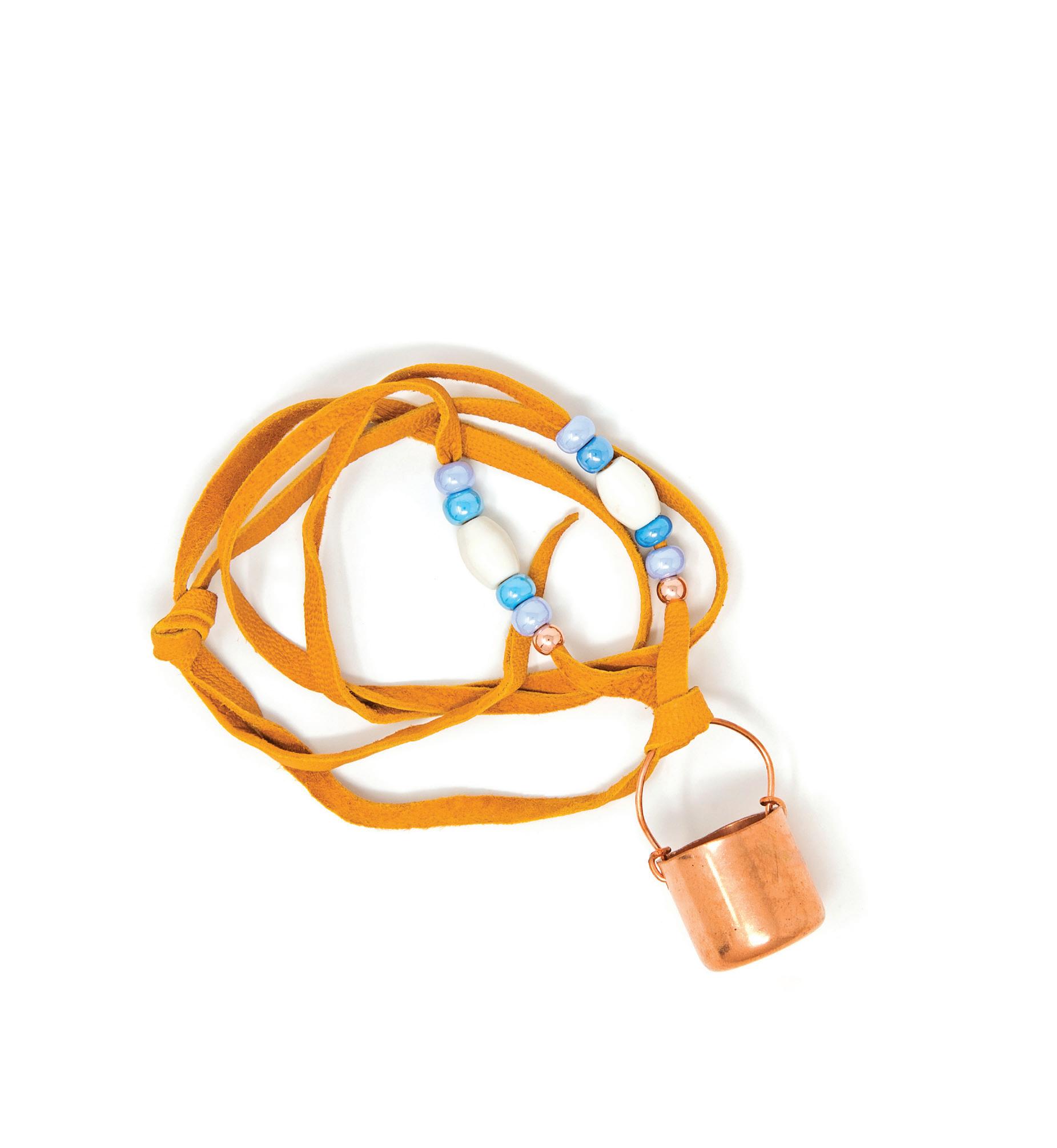 BY SILVER SEED CREATION
BY SILVER SEED CREATION
Available at ojibwe-cultural-foundation. myshopify.com
THE POWER OF STYLE BY CHRISTIAN
 ALLAIRE
ALLAIRE
Available online at ChaptersIndigo.ca,Amazon.ca
CEDAR CANOE HANDCRAFTED 100% SOY CANDLES INSPIRED BY ANISHINAABE STORIES, MEMORIES AND EXPERIENCES.


To order, contact Brooklyn and Savannah Penasse at cedarcanoecandles@ gmail.com or facebook.com/cedarcanoeco


To order, contact Trisha Pitura and Melanie Bernard at stores@minitipi.ca or visit minitipi.ca

“Style is not just the clothes on our backs—it is representation,self-expression,and transformation.”
Available at ojibwe-cultural-foundation. myshopify.com
Available in store in Wiikwemkoong Unceded Territory


Available online at facebook.com/yinslegacies
Available at legaleriste.com
Available at ojibwe-cultural-foundation. myshopify.com




 MASHKIIG DRESS BY MISHIIKENH KWE
BRACELET AND EARRINGS BY DARLENE BEBONANG
EVER NICE INDIGENOUS GIFT AND CRAFT SHOP
HEXAGON EARRINGS BY LACEY PANAMICK
CLOTHING BY YIN’S LEGACIES
MASHKIIG DRESS BY MISHIIKENH KWE
BRACELET AND EARRINGS BY DARLENE BEBONANG
EVER NICE INDIGENOUS GIFT AND CRAFT SHOP
HEXAGON EARRINGS BY LACEY PANAMICK
CLOTHING BY YIN’S LEGACIES
Much thought goes into work that we do and it begins with questions. Questions like: How do we normalize Anishinaabe culture and traditions experienced by our community while simultaneously embracing modern technology and lifestyle? How do we educate and support our community in knowing about their history and exercising their inherent rights? How do we assist in the holistic wellness of the members of our community?
There are many answers to these questions and examples of how we work towards providing appropriate and excellent care for our clients. Programs and services provided by our organization include a medical clinic, mental health services (counselling, art therapy, etc.), community programs (lunch and learns, physical activity promotion programs, life skills programming, etc.), Elder/Healer access, alternative high school, massage therapy/physiotherapy, and of course, traditional programs.
To expand on what is captured in our traditional programming, it starts with a round room referred to as the lodge in the centre of the clinic where clients who schedule themselves for appointments and programs also access time with their Elders. We have run hunt camps, youth culture camps. Community often joins us for teachings/workshops,
feasts, sweatlodge ceremonies, fasting camps and full moon ceremonies. In fact, for the first time this year, we hosted a Walking Out Ceremony. It is during the time that is spent learning, sharing and growing together that we honour our connections to the land, to each other, and within ourselves that show us that we are heading in the right direction as to figuring how to do the work in answering those questions.
I am immensely proud of my work as an Anishinaabe nini and equally as proud of our nation as a whole. We must carry forward our language, ways of life, our history and our teachings to maintain being the sovereign nation of the Anishinaabe people and continue to grow and understand what it means to be Anishinaabe. There is much to do but there are so many people working very hard to improve the health of our nation. It is a beautiful life. Miigwech.



Boozhoo Wakiya Ohitika Ndizhnikaaz Nimkii Pnesii Ndodem Chichtigaaning Ndoonjibaa. My Name is Dmitri Ashawasegai. As the Traditional Health Promoter at Shkagamik-Kwe Health Centre in Sudbury, I have a very interesting role in working for the Indigenous population in an urban community.




